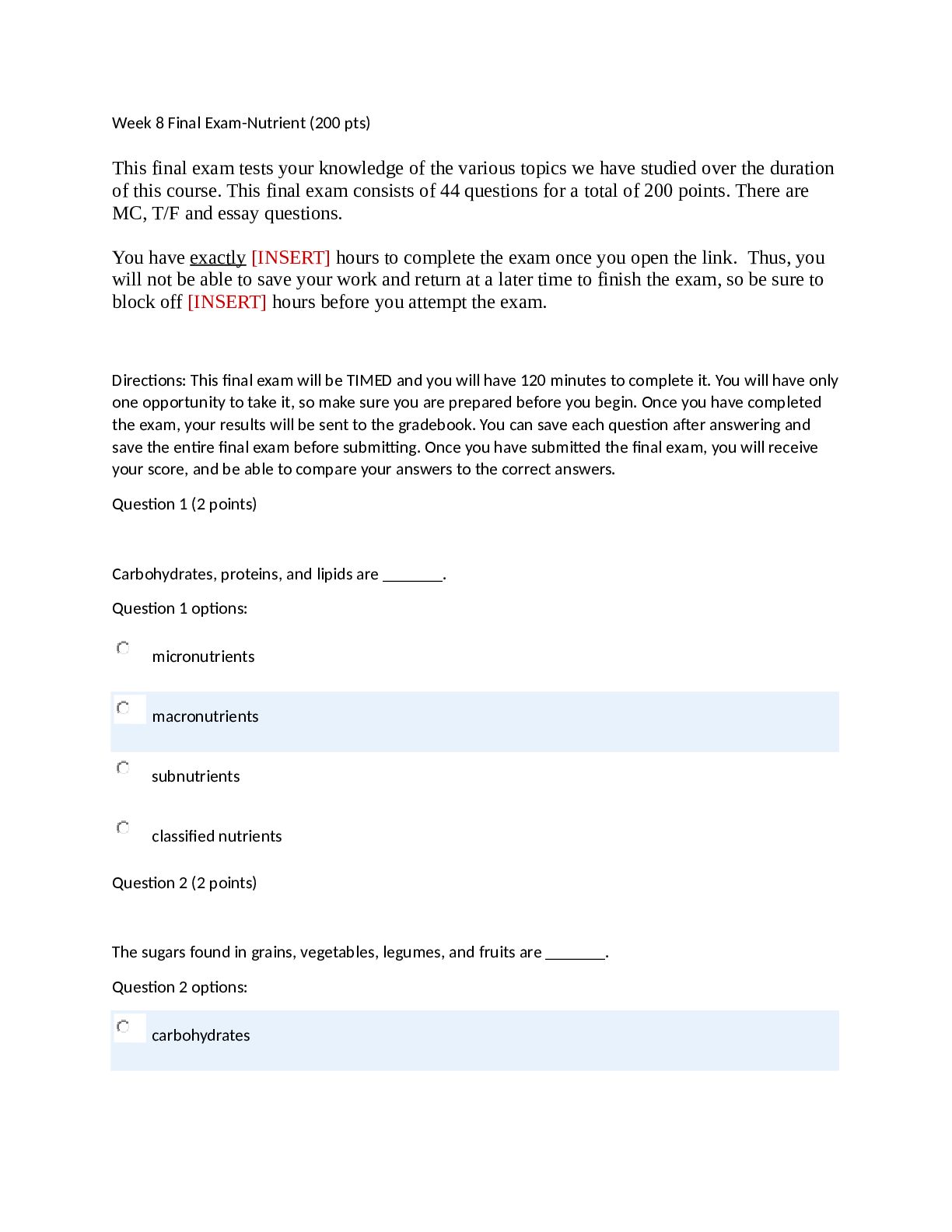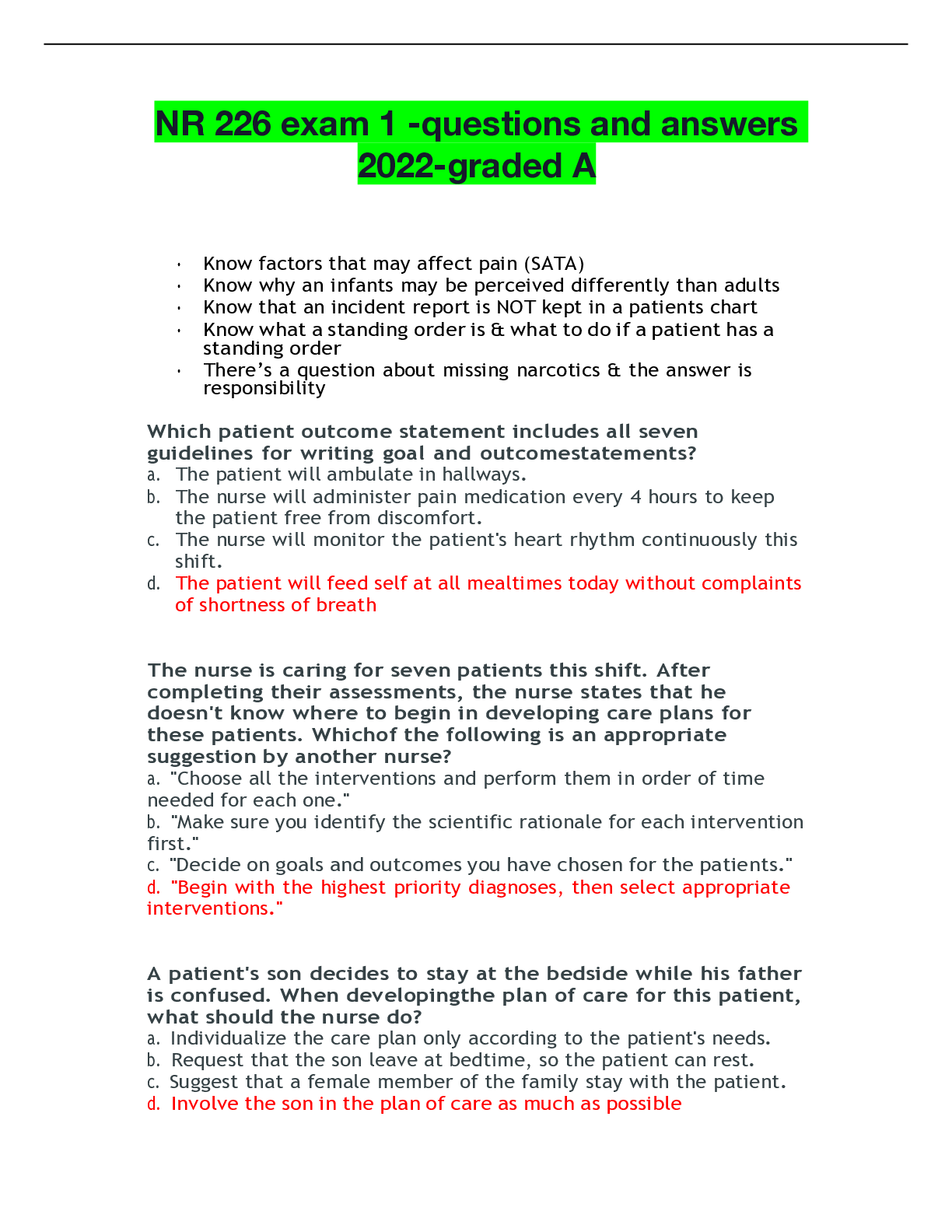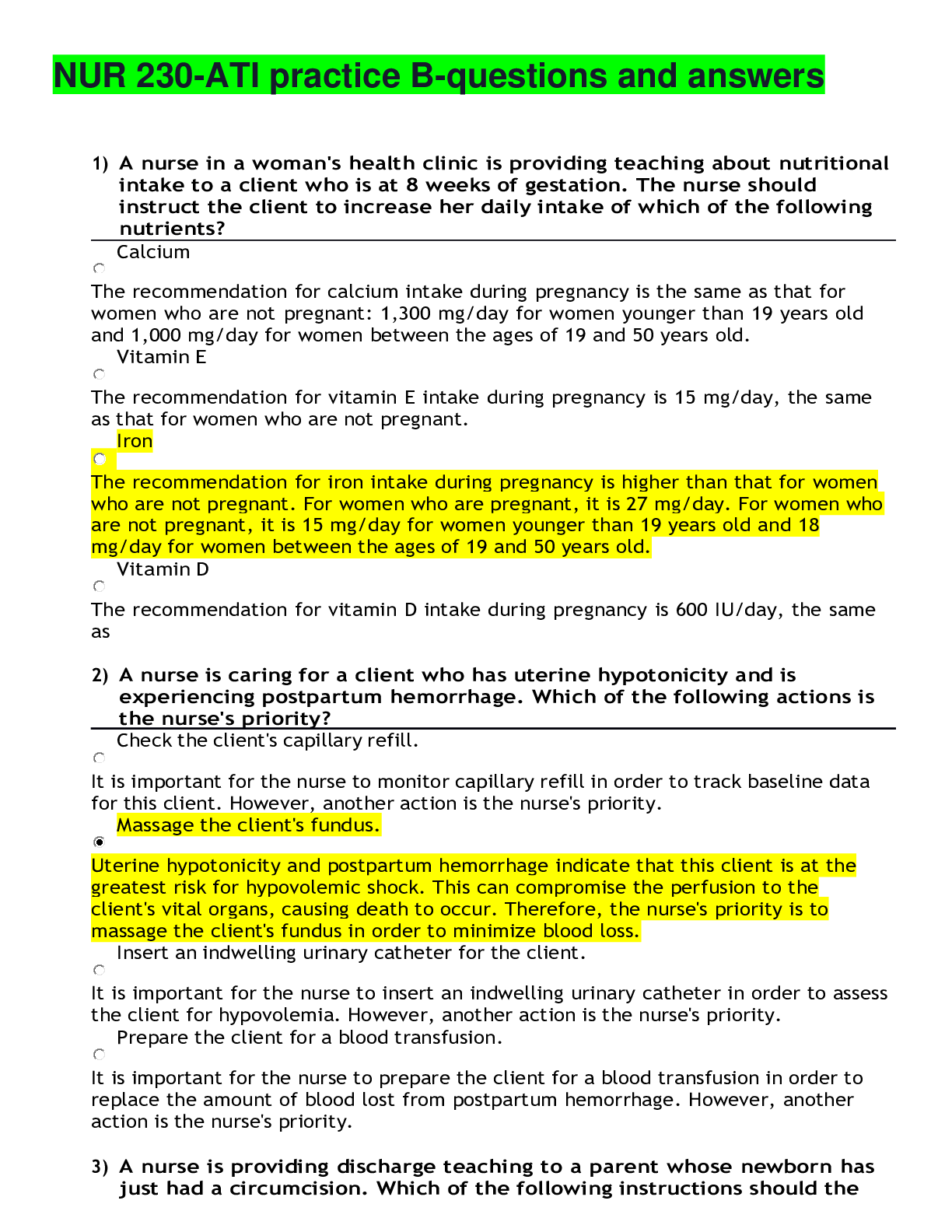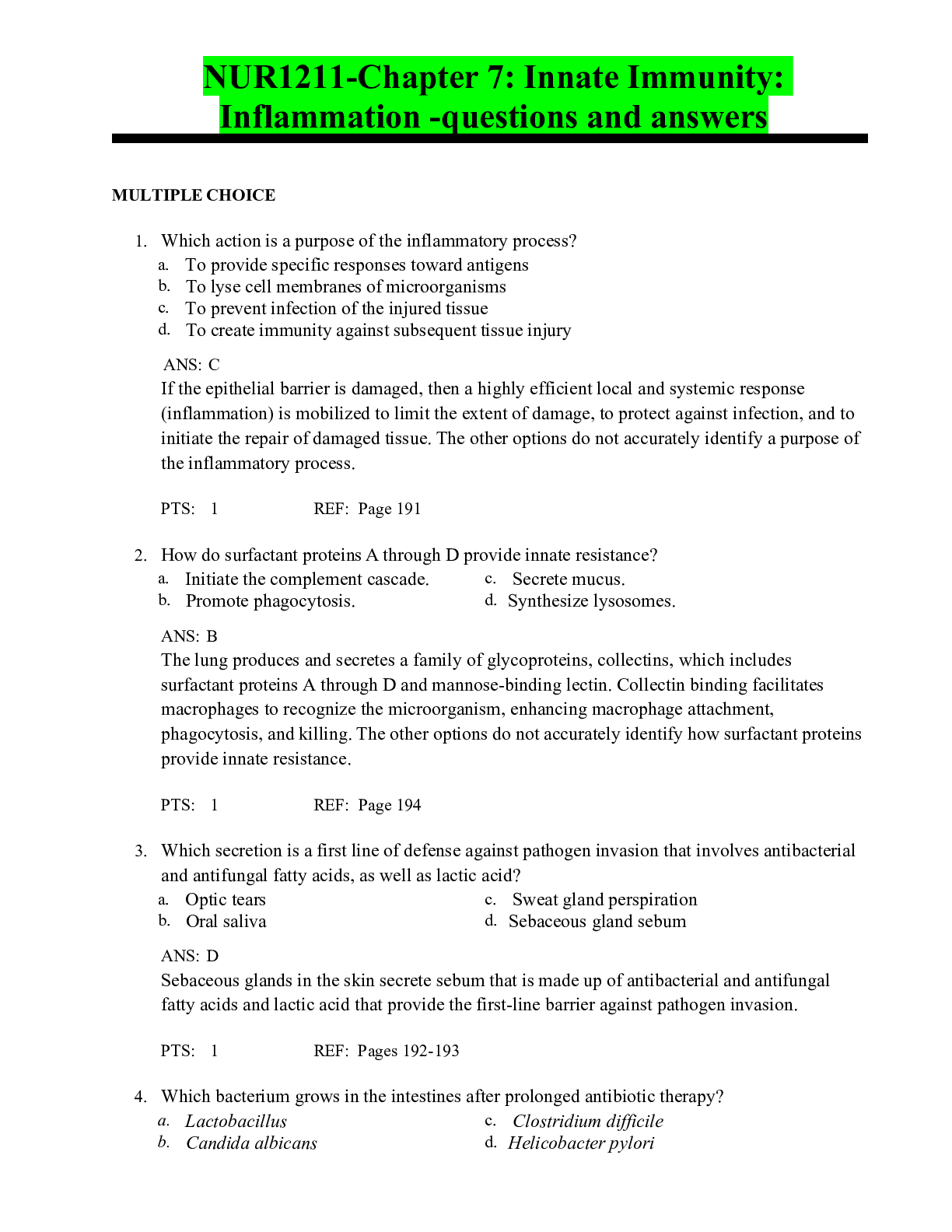Pathophysiology > EXAM > NURS 231 Pathophysiology Exam Reviews -Questions And Answers (All)
NURS 231 Pathophysiology Exam Reviews -Questions And Answers
Document Content and Description Below
Path 231 exams reviews Exam 1 Question 1 2.5 / 2.5 pts True/False: Persistent metaplasia can lead to dysplasia. Correct! True False Question 2 0 / 2.5 pts True/False: Barrett esophagus is ... an example of dysplasia. You Answered True Correct Answer False Question 3 2.5 / 2.5 pts True/False: Cervical intraepithelial neoplasia is a type of dysplasia. Correct! True False Question 4 0 / 2.5 pts True/False: Endometrial hyperplasia is a normal physiologic occurrence. You Answered True Correct Answer False Question 5 10 / 10 pts Match the following: 1. Proportion of people with a disease who are positive for that disease a. Validity 2. How likely the same result will occur if repeated b. Reliability 3. How a tool measures what it is intended to measure c. Sensitivity 4. People without the disease who are negative on a given test d. Specificity Correct! Proportion of people with a disease who are positive for that disease c. Sensitivity Correct! How likely the same result will occur if repeated Correct! How a tool measures what it is intended to measure Correct! People without the disease who are negative on a given test Question 6 1.25 / 2.5 pts Multiple Choice Which are true of the mitochondria? Select all that apply. Correct! It is involved in cellular respiration You Answered They are found far from the site of energy consumption Correct! They play a role in apoptosis They control free radicals Question 7 1.25 / 2.5 pts Which of the following are true regarding cell communication? Select all that apply. b. Reliability a. Validity d. Specificity You Answered Paracrine signaling depends on hormones Correct! Neurotransmitters act through synapses Enzyme linked receptors act through an on-off switch Correct! Autocrine signaling releases a chemical into the extracellular fluid that affects its own activity Question 8 2.5 / 2.5 pts Multiple Choice Which of the following are false of the cell? Proteins carry out the functions of the cell membrane. Lysosomes are the digestive system of the cell. Correct! The rough ER is the site for lipid synthesis. Microfilaments are thin, threadlike cytoplasmic structures. Question 9 2.5 / 2.5 pts Which is true of the cytoskeleton? Select all that apply. Correct! It controls shape and movement Correct! Cilia and flagella are microtubule-filled cellular extensions It includes peroxisomes and proteasomes Question 10 1.88 / 2.5 pts What factors are used by epidemiologic methods? Select all that apply. Correct! How disease is spread Correct! How to control disease Correct! How to prevent disease Correct! How to eliminate disease You Answered How to treat disease All of the above None of the above Question 11 2.5 / 2.5 pts Multiple Choice A patient complains of a sore throat and headache. What are these examples of? Signs Correct! Symptoms Both A & B Question 12 0 / 2.5 pts Multiple Choice Which of the following is NOT helpful to the clinician to make a diagnosis? You Answered Detailed history Physical exam Correct Answer Evidence based practice Laboratory tests Question 13 0 / 2.5 pts Multiple Choice Chemical agents (poison, alcohol) are examples of which of the following? You Answered Risk factors Clinical manifestations Pathogenesis Correct Answer Etiologic factors Question 14 10 / 10 pts Define primary prevention and give an example: Your Answer: when the risk factors has to be remove to stop the disease from occurring example-eathing healthy / exercising to stay in shape or prevent heart disease.Giving vaccination to pervent disease in children The goal of primary prevention is to remove risk factors to prevent disease from occurring. Examples include taking folic acid while pregnant to prevent neural tube defects, vaccinating children to prevent communicable disease, eating healthy and exercising to prevent heart disease, and wearing seatbelts or helmets. Question 15 10 / 10 pts Explain apoptosis and why it is necessary: Your Answer: apoptosis is the programmed of cell death.this process is necessary for cell dividing because it is removing unwanted cells to make way for new cell. Apoptosis is programmed cell death. This process eliminates cells that are worn out, have been produced in excess, have developed improperly, or have genetic damage. Apoptosis is also responsible for several normal physiologic processes, like replacing cell in the intestinal villi and removing aging red blood cells. Question 16 10 / 10 pts Explain what necrosis is and give an example and description of one type of necrosis. Your Answer: necrosis is when cell dies in an organ/tissues that is still alive .this process can interferes with the tissue regeneration and how cell can be replace. one type of necrosis is gengrenouse necrosis which can bowel or the lower extremities that may causes changes in tussue and it functions Necrosis refers to cell death in an organ or tissues that is still part of a living person. It often interferes with cell replacement and tissue regeneration. Coagulative necrosis results most often from a sudden cutoff of blood supply to an organ (ischemia), particularly the heart and kidney. Liquefactive necrosis occurs when some of the cells die but their catalytic enzymes are not destroyed. It is commonly seen with brain infarcts or abscesses. Caseous necrosis occurs as part of granulomatous inflammation and is most often associated with tuberculosis. Gangrenous necrosis most often affects the lower extremities or bowel and is secondary to vascular occlusion. The term gangrene is applied when a considerable mass of tissue undergoes necrosis. In dry gangrene the affected tissue becomes dry and shrinks, the skin wrinkles, and its color changes to dark brown or black. The spread of dry gangrene is slow. It results from a cut off in arterial blood supply and is a form of coagulation necrosis. In wet gangrene, the affected area is cold, swollen, and pulseless. The skin is moist, black, and under tension. Blebs form on the surface, liquefaction occurs, and a foul odor is caused by bacterial action. The spread of tissue damage is rapid. Question 17 9 / 10 pts Match the type of cell injury to the cause. Some answers may be used more than once. (1 point each) 1. Sunburn a. Physical agents 2. Obesity b. Radiation injury 3. Reactive oxygen species c. Chemical injury 4. Low oxygen to tissues d. Biologic agents 5. Fractures e. Nutritional imbalances 6. OTC drugs f. Free radical injury 7. Hypothermia g. Hypoxic cell injury 8. Radiation treatment 9. Lead toxicity 10. Bacteria Correct! Sunburn Correct! Obesity You Answered Reactive oxygen species Correct Answer f. Free radical injury Correct! Low oxygen to tissues Correct! Fractures Correct! OTC drugs Correct! Hypothermia Correct! b. Radiation injury e. Nutritional imbalances c. Chemical injury g. Hypoxic cell injury a. Physical agents c. Chemical injury a. Physical agents Radiation treatment Correct! Lead toxicity Correct! Bacteria Question 18 5 / 10 pts List the 4 types of tissue found in the body. Pick 2 and give a description and example of each. Your Answer: nervours tissue-can be find throughout the body and it's used for communication. muscle tissue connective tissue epithelial-(covers the outer surface of the body and lines the inner surfaces. Epithelial tissue covers the body’s outer surface, lines the inner surfaces, and forms glandular tissue. Epithelial tissue has three distinct surfaces and the basal surface is attached to an underlying basement membrane. It is avascular, meaning without blood vessels. It receives oxygen and nutrients from the capillaries of the connective tissue on which it rests. Connective or supportive tissue is the most abundant tissue in the body. It connects and binds or supports the various tissues. Its cells produce the extracellular matrix that support and hold tissues together. Connective tissue is divided into two types: connective tissue proper and specialized connective tissue (cartilage, bone, and blood cells). The four types of connective tissue proper are loose (areolar), adipose, reticular, and dense connective tissue. The function of muscle tissue is to move the skeletal structures, pump blood through the heart, and contract the blood vessels and visceral organs. Muscle tissue can accomplish this by contraction. The two types of fibers that contract are called thin and thick filaments. Thin filaments are called actin, and the thick filaments are myosin. The three types of muscles tissue are skeletal, cardiac, and smooth. Nervous tissue is distributed throughout the body for communication. It provides the means for controlling body function and for sensing and moving about the environment. b. Radiation injury c. Chemical injury d. Biologic agents The two types of cells are neuron and glial cells. Neurons function is communication. Glial (meaning glue) cells support the neurons. Question 19 2.5 / 2.5 pts What term means “cell eating” and engulfs and then kills microorganisms or other particulate matter? Your Answer: cell eating is refered to phagocytosis Phagocytosis Question 20 2.5 / 2.5 pts What term means “cell drinking,” and engulfs small solid or fluid particles, as seen with proteins and electrolytes? Your Answer: cell drinking is refrered to pinocytosis Pinocytosis Question 21 2.5 / 2.5 pts Give one function of a membrane potential: Your Answer: membrane potential can causes music contractions Generate nerve impulse, muscle contractions, or cause hormone secretion Question 22 2.5 / 2.5 pts What is the term that best describes the following process? A transport protein aiding a lipid insoluble or large molecule across the cell membrane that would otherwise not be able to pass through on its own. Your Answer: Facilitated diffusion facilitated diffusion Exam 2 Question 1 3 / 3 pts True/False: Blood tests for tumor markers can make a diagnosis of cancer. Why or why not? Your Answer: false,because tumor are usually elevated in benign conditions ,and in the early stages of malignancy they can't be elevated. False, only tissue can diagnose. Tumor markers are helpful to assess response to therapy or reoccurrence. Question 2 3 / 3 pts What is the most important procedure in diagnosing the correct cancer and histology? Your Answer: tissue biopsy because they play a critical role in dignosing the right cancer and histology tissue biopsy Question 3 4 / 4 pts Explain the TNM system: Your Answer: is a staging system that was created by AJCC for the help study cancer.It is also very effective in classifieng cancers tumor componments. Classification goes as such: T relates to the local spread of the primary of the tumor and the size N relates to the involvement of the regional/location of the lymph nodes M is the extent of the metastatic invilvement T is the size and local spread of the primary tumor. N is the involvement of the regional lymph nodes. M is the extent of the metastatic involvement. Question 4 10 / 10 pts 1. List two signs or symptoms a patient may present with that might indicate a cancer diagnosis: 2. What are two side effects commonly experienced by cancer patients? Your Answer: 1) Bleeding and weight loss 2) hair loss and sleep disturbances 1. Bleeding; sore that doesn’t heal; fluid in the pleural, pericardial, or peritoneal spaces; chest pain, shortness of breath, cough, abdominal discomfort or swelling. Other possible answers can include a mass or lump, pain (need to be specific), fatigue, fevers, weight loss 2. Weight loss, wasting of body fat and muscle tissue, weakness, anorexia, and anemia, fatigue, sleep disturbances Question 5 10 / 10 pts 1. What are the three possible goals of cancer treatment? 2. How does radiation kill cancer cells? Your Answer: 1) the three goal is to curative,control and palliative 2) radiation kill cancer cells by using high energy/waves particles to destroy/damage cancer cells.However this treatment can sometimes interrupt the cells cycle by killing good cells or damaging DNA cells 1. Curative, control, palliative 2. Radiation therapy uses high-energy particles or waves to destroy or damage cancer cells. This leads to the creation of free radicals, which damage cell structures. Radiation can interrupt the cell cycle process, kill cells, or damage DNA in the cells. Question 6 2.5 / 2.5 pts True/False: Cell proliferation is the process in which proliferating cells become more specialized cell types. True Correct! False False, cell differentiation Question 7 0 / 2.5 pts True/False: Cell differentiation is the process in which proliferating cells become more specialized cell types. Correct Answer True You Answered False Question 8 2.5 / 2.5 pts This type of cell remains incompletely differentiated throughout life: Your Answer: stem cell stem cell Question 9 2.5 / 2.5 pts These are cells of the same lineage that have not yet differentiated to the extent that they have lost their ability to divide: Your Answer: they are progenitor progenitor or parent cells Question 10 4 / 4 pts What is angiogenesis? Why do tumors need it? Your Answer: angiogenesis is the delovement of new blood vessels with a tumor and tumorns need angiogenesis to grow development of new blood vessels within the tumor. They need it to continue to grow. Question 11 3 / 3 pts What are normal genes called that become cancer-causing if mutated? Your Answer: proto-oncogenes protooncogenes Question 12 3 / 3 pts What is a tumor suppressor gene? Give one example. Your Answer: they're gene that are associated with gene underactivity because of this it slows down cell division or may tell cell when to die. Tumor suppressor genes are associated with gene underactivity. These genes slow down cell division, repair DNA mistakes, or tell cells when to die. BRCA1 or 2, TP53 Question 13 10 / 10 pts A 40-year-old woman has experienced heavy menstrual bleeding. She was told she has a uterine tumor called a leiomyoma. She is worried she has cancer. What do you tell her? Explain at least 2 differences between a benign and malignant tumor. Your Answer: I will tell her not to worry because leiomyoma is a non-cancerous tumor and it can be surgically remove and to always have a regular doctor visit two differences between a benign and malignant tumor is that has a well-differentiated cells and have slow progressive growth rate.Malignant tumor is more aggressive because it destroy tissue,grows rapidly and spread to other body parts and lacks well defined margins Leiomyoma is a benign tumor. (Leiomyosarcoma is malignant) Student can add any of the following: Benign tumors are well-differentiated cells, resemble the cells of tissues of origin, and have a slow, progressive rate of growth. They grow by expansion and remain localized to their site of origin, not capable of metastasizing. They develop a rim of connective tissue around the tumor called a fibrous capsule, which aids in surgical removal. Benign tumors are less of a threat unless they interfere with vital functions Malignant neoplasms invade and destroy tissue. They grow rapidly, spread to other parts of the body, and lack well-defined margins. They can compress blood vessels and outgrow their blood supply, causing ischemia and tissue injury. Surgery can be more difficult if it has spread. Question 14 10 / 10 pts A 62-year-old man with a 30-pack year smoking history is diagnosed with small cell lung cancer with metastasis to the bone. (1) Explain the process of how cancer spreads metastatically. (2) What symptoms might he have presented with? (3) Which screening test would he have benefited from? Your Answer: 1) cancern that are spreads by metastatically is loose from the primary tumor that have extracellular matrix from the surrounding tumor,or has gain access to the blood vessle which it can grow and establish a blood supply. 2 some symptoms that may be presented are shortness of breath,chest or bone pain and cough 3) hw benefited from low dose chest CT that could be done yearly (1) Metastasis- a cancer cell must break loose from the primary tumor, invade the surrounding extracellular matrix, gain access to a blood vessel, survive its passage in the bloodstream, emerge at a favorable location, invade the surrounding tissue, begin to grow, and establish a blood supply. (2) Chest pain, shortness of breath, cough, bone pain. (3) Yearly low-dose chest CT. Question 15 1.5 / 3 pts Malignant tumors have which of the following characteristics? Select all that apply. Correct! Variable rate of growth Correct! Spreads by metastasis Well-differentiated cells You Answered Fibrous capsule Question 16 0 / 3 pts What are molecular and cellular mechanisms in genes that increase susceptibility to cancer? Select all that apply. Correct Answer Lack of cellular senescence Correct! Angiogenesis You Answered Ability to undergo apoptosis Correct! Mutations in growth factor signaling pathways You Answered Intact DNA repair genes Question 17 4 / 4 pts List 4 of the 7 risk factors linked to cancer as stated in the module. Your Answer: 1)obesity 2)hormonal factors 3)environmental agents 4) cancer causing viruses Heredity, hormonal factors, obesity, immunologic mechanisms, environmental agents such as chemicals, radiation, and cancer-causing viruses. Question 18 10 / 10 pts List three characteristics of cancer cells and briefly explain what it means: Your Answer: cancer cells grow in an altered cell differentiation and growth which can also be called neoplasia they can have a neoplasm growth where normal tissue lacks regulatory controls cancer cells also have genetic abnormalities that causes uncontrollble proliferation and can cause normal call or benign tumors into malignant tumors Answer: Any of the following Anaplasia is the loss of cell differentiation in cancerous tissue. Genetic instability means they have a high frequency of mutations. Growth factor independence means cancer cells can proliferate even in the absence of growth factors. Cell density-dependent inhibition means cancer cell don’t stop growing when they come into contact with each other. Cell cohesiveness and adhesion means they don’t stick together. Anchorage dependence means cancer cells aren’t anchored to neighboring cells or the underlying matrix to live and grow. Cell-to-cell communication in cancer cells is poor, which interferes with intercellular connections and responsiveness to membrane-derived signals. Life span is unlimited – cancer cells are immortal. Antigen expression -cancer cells contain several cell surface molecules or antigens that are immunologically identified as foreign. Cancer cells can produce enzymes, hormones, and other substances that the tissues of origin either does not produce or produces in much smaller amounts. Cancer cells can show cytoskeletal changes or abnormalities. This includes abnormal intermediate filament types or changes in actin filaments and microtubules that help with invasion and metastasis. Question 19 3.5 / 3.5 pts Which of the following is not a risk factor for developing cancer? Correct! Sunscreen Obesity HPV High red meat intake Question 20 3.5 / 3.5 pts All of the following viral agents are correctly paired with the associated lesion except: Human papillomavirus (HPV): genital warts Correct! Epstein-Barr virus: carcinoma of the cervix Epstein Barr is linked to Burkitt lymphoma and nasopharyngeal cancer. Cervical carcinoma is linked to HPV. Hepatitis B virus: hepatocellular carcinoma Human herpes virus-8: Kaposi sarcoma Question 21 3 / 3 pts List one example of screening for each method: observation, palpation, and lab test/procedure: Your Answer: observation-external genitalia palpation-lymph nodes lab test/procedure-pap smear Observation: skin, mouth, external genitalia Palpation: breast, thyroid, rectum and anus, prostate, lymph nodes Laboratory tests and procedures: Pap smear, colonoscopy, mammography Exam 3 Question 1 5 / 5 pts Short answer Explain the challenges of diagnosing autoimmune disorders. Your Answer: since there are too many autoimmune disorder,diagnosing is made by serological finding,history or physical testing.blood testing could have been a good way to test but since some blood are more generic can be elevated to show other diseases therefore it best go by finding that are listed. There are over 80 identified, many with overlapping presentations. Many manifestations are nonspecific and are seen in other non-autoimmune diseases. Blood testing isn’t perfect either, as some tests are more generic and can be elevated in the presence of other diseases. Question 2 2.5 / 2.5 pts Multiple choice: Which cell is the first responder to phagocytose a foreign invader? Correct! Monocyte Basophil Eosinophil Dendritic cell Question 3 2.5 / 2.5 pts Multiple Choice: What are the primary cells involved in the adaptive immune response? Antibodies Antigens Neutrophils Correct! Lymphocytes Question 4 3 / 3 pts B lymphocytes produce what type of immunity? Your Answer: humoral immunity humoral Question 5 2 / 2 pts Multiple Choice: Which immunoglobulin is responsible in inflammation and allergic responses and combating parasitic infections? IgM Correct! IgE IgA IgD IgG Question 6 2 / 2 pts Multiple Choice: Which cell type is an early responder and the most abundant in the body? Lymphocytes Eosinophils Basophils Correct! Neutrophils Question 7 3.5 / 3.5 pts Multiple Choice: Which is NOT a finding consistent with Graves’ disease? Exophthalmos Correct! Hypothyroidism hyperthyroidism Goiter Corneal ulceration Question 8 10 / 10 pts A 12-year-old female presents with itchy eyes, nasal congestion and drainage, and sneezing every spring when the pollen count is high. (1) Explain the immunologic mechanisms that are responsible for her symptoms. (2) What type(s) of treatment might be used to relieve her symptoms? Your Answer: it can be a cause od Type I hypersensitivety/ IGE as well as allergy, which is responisible for her symptoms and treatment such as penicillin or some allergy medications (1) Mast cells, basophils, and eosinophils play an important role in the development of type I reactions because they contain the chemical mediator histamine. A primary or initialphase response is vasodilation, vascular leakage, and smooth muscle contraction. A secondary or late-phase response is characterized by more intense infiltration of tissues with eosinophils and other acute and chronic inflammatory cells, as well as tissue damage. (2) Antihistamines and intranasal corticosteroids are the mainstay of treatment. Question 9 3.5 / 3.5 pts True/False: An antibiotic alone will heal an abscess. If false explain why: Your Answer: false,because there be some pus in there that need ro be drained to make sure that the area don't infected false, antibiotics can’t penetrate the abscess wall, so incision and drainage are necessary. Question 10 3 / 3 pts Multiple Choice: An appendectomy is performed on a 16-year-old boy who is hospitalized for right lower quadrant abdominal pain of 18 hours’ duration. The surgical specimen is edematous and erythematous. An infiltrate of which of the following cells would be most characteristic of the process occurring here? Correct! Neutrophils Neutrophils are the most characteristic cellular component of the early stages of acute inflammation. Eosinophils Basophils Lymphocytes Monocytes Question 11 0 / 3.5 pts True/False: During inflammation, blood vessels constrict to minimize tissue damage. You Answered True Correct Answer False Question 12 0 / 3 pts True/False: Active immunity provides long lasting protection. Correct Answer True You Answered False Question 13 0 / 2.5 pts True/False: B lymphocytes normally produce antibodies against host tissues. You Answered True Correct Answer False Question 14 3.5 / 3.5 pts Antibodies are also known as ______? Your Answer: immunoglobulins immunoglobulins Question 15 3.5 / 3.5 pts Multiple Choice: Which of the following hypersensitivity reactions can be treated with the administration of epinephrine? Correct! Type I Type II Type III Type IV Question 16 0 / 3.5 pts Multiple Choice: Which is NOT a type of type II hypersensitivity reaction? Correct Answer Antigen-mediated cellular inflammation antibody-mediated cellular dysfunction You Answered Complement- and antibody-mediated inflammation antibody-dependent cell cytotoxicity complement-activated cell destruction Question 17 3.5 / 3.5 pts Multiple Choice: A finding of diagnostic significance is the well-known association of HLA-B27 antigen with which of the following disorders? Rheumatoid arthritis Systemic lupus erythematosus (SLE) Correct! Ankylosing spondylitis HLA-B27 antigen is found in almost 90% of patients with ankylosing spondylitis Graves’ disease Question 18 5 / 5 pts Short answer: What are autoantibodies? Your Answer: when the immune system don't have the ability to recognize itself and produces autoantibodies that acts againist host tissues Answer: In many autoimmune diseases, the immune system loses its ability to recognize self and produces what is called autoantibodies, which act against host tissues. Question 19 5 / 10 pts 1, A 32-year-old woman presents to the clinic for her initial obstetrics visit, about 10 weeks into her pregnancy. She is in a monogamous relationship. (1) Should an HIV test be part of her initial blood work? Why? 2. An infant is born, and its initial antibody test is positive for HIV. (2) Does this mean the infant is infected? What would be the more appropriate test to detect HIV in this infant? Your Answer: Although she's in a monogamous relationship and have one partner it is still a good idea to test for HIV in her initial blood work because if tested positive,it can be transmet directly to the baby through birth or in the mother milk while breastfeeding. 2) yes,the baby has been infected most likely the virus has been transmission from it's mother,and the most appropriate test to detect HIV in this infants will be to use the DNA/RNA polymerase cain reaction (PCR) becaue the infants would still have ther mother's antibodies 1. Yes. Transmission from mother to infant is the most common way that children become infected. The CDC recommends all people between ages 13 and 64 be routinely screened for HIV. Earlier detection and treatment lead to better outcomes. 2. No. The polymerase chain reaction (PCR) test is a nucleic acid test that can detect HIV DNA. It tests for the presence of the virus, rather than the antibody, which is helpful in diagnosing HIV infection in infants born to infected mothers. These infants would have their mother’s antibodies whether or not they have been infected. Question 20 3.5 / 3.5 pts Multiple Choice: Which of the following will promote wound healing? Malnutrition Correct! Increased blood flow Infection Foreign bodies Question 21 3.5 / 3.5 pts Multiple Choice: Which of the following cells is a permanent cell? Epidermal cell Hepatocyte Intestinal mucosal cell Correct! Neuron Renal tubular cell Question 22 3.5 / 3.5 pts Fill in the blank As the CD4 T cell count decreases, the body becomes susceptible to ______ ______. Your Answer: opportunistic infections Answer: opportunistic infections Question 23 3.5 / 3.5 pts The time between HIV infection and seroconversion is called what? Your Answer: the window period Answer: the window period Question 24 3.5 / 3.5 pts True/False: A person with HIV is not infectious when they are asymptomatic. True Correct! False Question 25 0 / 2.5 pts True/False: The T cells that display the host’s MHC antigens and T-cell receptors for a nonself-antigen are allowed to mature, a process termed negative selection. You Answered True Correct Answer False Question 26 0 / 2.5 pts Multiple Choice: What cell mediator is the primary cause of vasodilation seen in acute inflammation? Endothelial cells You Answered Platelets Correct Answer Histamine Neutrophils Question 27 2.5 / 2.5 pts Multiple Choice: Which cell in the blood provides primary hemostasis? Correct! Platelets Endothelial cells Histamine Macrophages EXAM 4 Question 1 2.5 / 2.5 pts The coagulation cascade involves each of the following except: Correct! Make thrombocytes Activate the intrinsic and extrinsic pathways Convert fibrinogen to fibrin Convert prothrombin to thrombin Question 2 0 / 2.5 pts Which of the following are natural anticoagulants? Select all that apply. Factor II You Answered Factor VII You Answered Factor IX You Answered Factor X Correct! Protein C Correct! Protein S Question 3 0 / 2.5 pts Which of the following is NOT a hypercoagulable state? Select all that apply. You Answered Oral contraceptive use Mutation of prothrombin gene Correct! Hemophilia A Correct Answer Hemophilia B Immobility Question 4 1.25 / 2.5 pts Which of the following are TRUE of hemophilia A? Select all that apply. Correct! Spontaneous joint bleeding can occur You Answered The platelet count is decreased Aspirin and NSAIDS are the mainstay of treatment Correct! The PTT is increased Question 5 2.5 / 2.5 pts Well-known causes of disseminated intravascular coagulation (DIC) include each of the following conditions except: Retained dead fetus Carcinoma Gram-negative sepsis Correct! Heparin administration Question 6 0 / 2.5 pts Which of the following increases the strength of the muscular contraction? Wall tension Correct Answer Inotropic influence You Answered Peripheral vascular resistance Hypoxia Question 7 2.5 / 2.5 pts Which of the following is true of the renin-angiotensin-aldosterone system? Angiotensin I is converted to angiotensin II in the kidneys Angiotensin II is a potent vasodilator Correct! Angiotensin II increases sodium reabsorption in the kidney by stimulating the secretion of aldosterone The PVR is decreased Question 8 2.5 / 2.5 pts Which of the following terms refers to the pressure the heart must generate to move blood into the aorta? Correct! Afterload Inotrope Preload Ejection fraction Question 9 2.5 / 2.5 pts Multiple Choice What is the most specific test for diagnosing iron deficiency anemia? Correct! Ferritin RBC Total iron binding capacity Hematocrit Question 10 2.5 / 2.5 pts Multiple Choice What are the two most common causes of macrocytic anemia? Iron deficiency anemia, Thalassemias Folate deficiency, Sickle cell disease Sickle cell disease, Vitamin B12 deficiency Correct! Vitamin B12 deficiency and Folate deficiency Question 11 2.5 / 2.5 pts Multiple Choice Which of the following is FALSE regarding sickle cell disease? Abnormality of HbS gene Blood vessel occlusion is a complication Correct! Average red cell lifespan is 60 days Can lead to encapsulated infections Question 12 2.5 / 2.5 pts Multiple Choice: A 23-year-old African-American man with a history of severe lifelong anemia requiring many transfusions has nonhealing leg ulcers and recurrent periods of abdominal and chest pain. These signs and symptoms are most likely to be associated with which one of the following laboratory abnormalities? Correct! Sickle cells on peripheral blood smear Loss of intrinsic factor Decreased erythropoietin Decreased ferritin Question 13 0 / 2.5 pts Multiple Choice: Which of the following is NOT true of vitamin B12 deficiency anemia? Vitamin B12 is bound to intrinsic factor Peripheral neuropathy can be a result of deficiency Correct Answer Dietary deficiencies are common You Answered MCV is elevated Question 14 2.5 / 2.5 pts Multiple Choice: Each of the following are risk factors for secondary hyperlipidemia except? Obesity Diabetes mellitus High cholesterol diet Correct! Autosomal dominant disorder of LDL receptor Question 15 0 / 2.5 pts Multiple Choice: Lifestyle changes to treat hyperlipidemia include each of the following except: Increase physical activity Correct Answer Increase red meat consumption You Answered Smoking cessation Weight reduction Question 16 2.5 / 2.5 pts Multiple Choice: Which of the following is true of fatty streaks of atherosclerotic lesions? Present in adults only Can be symptomatic Form scar tissue and calcifications Correct! Consist of macrophages and smooth muscle cells Question 17 10 / 10 pts Multiple Choice: 1. The three major determinants of myocardial oxygen demand (MVO2) include each of the following except: a. Diastolic pressure b. Heart rate c. Left ventricular contractility d. Systolic pressure Fill in the Blank: 2. ______ is the most important factor in myocardial oxygen demand. As this increases, myocardial oxygen consumption or demand also increases. Multiple Choice: 3. What is the most common cause of cardiogenic shock? a. Heart failure b. Cardiomyopathy c. Myocardial infarction d. Hypertension Multiple Choice: 4. Which does NOT occur during cardiogenic shock? a. Decreased cardiac output b. Hypotension c. Hypoperfusion d. Decreased systemic vascular resistance Your Answer: 1) A 2)heart rate 3) C 4) D 1. A 2. Heart rate 3. C 4. D Question 18 10 / 10 pts 1. Explain how ventricular hypertrophy is an adaptive mechanism: 2. What happens during exercise in someone with coronary artery disease? Your Answer: 1 by increasing the cardica output or physical myocardial changes 2 they might have streangth the heart muscle and improve over all hearth or lower chances of heart attack 1. An increase in wall stress can be caused by an increase in preload or afterload. Ventricular hypertrophy is an adaptive mechanism by which the ventricle can offset the increase in wall stress. OR Blood pressure elevation increases the workload of the left ventricle by increasing the pressure against which the heart must pump as it ejects blood into the systemic circulation. Over time, the left ventricle hypertrophies to compensate for the increased pressure and work. 2. During exertion, the heart beats harder and faster to supply oxygen to the muscles. The coronary vessels vasodilate and increase blood flow to the cardiac muscle to meet its increased demand for oxygen. With atherosclerotic disease, the coronary vessel lumens are narrowed and blood supply to the heart is diminished. With exertion, the vessels cannot adequately vasodilate. This can manifest as chest pain or tightness and/or shortness of breath. Question 19 10 / 10 pts 1. Hypertension is often called “the silent killer.” By the time symptoms of hypertension occur, the complications can affect the kidneys, heart, eyes, and blood vessels. What is this term called? 2. Left ventricular hypertrophy is a major risk factor for what other diseases? Name at least 2. Your Answer: 1 Target organ damage 2 it can cause heart diseases such as heart attack or storke 1. Target-organ damage 2. coronary heart disease, cardiac dysrhythmias, congestive heart failure, and sudden death. Question 20 2.5 / 2.5 pts Multiple Choice: With increasing occlusion of the coronary vessel(s), the demands of the resting heart may become too great. When the patient experiences angina without exertion, or when the level of exertion necessary to cause anginal symptoms decreases, this is called what? Stable angina Correct! Unstable angina Myocardial infarction Question 21 2.5 / 2.5 pts Multiple Choice: Which of the following is NOT a risk factor for hypertension? Correct! Increased potassium intake Increased salt intake Increased alcohol intake Increased caloric intake Question 22 2.5 / 2.5 pts Multiple Choice: Upon seeing this on your patient, which disease would you screen for? Gout Hypertension Heart failure Correct! Hyperlipidemia Question 23 2.5 / 2.5 pts Multiple Choice: Which pharmacologic treatment of hypertension has a mechanism of action characterized by reducing vascular smooth muscle tone (vasodilation) and reducing cardiac contractility and heart rate? Diuretics Correct! Calcium channel blockers Beta-blockers Ace-inhibitors Question 24 2.5 / 2.5 pts Multiple Choice: Which arrhythmia is the most common chronic arrhythmia and incidence increases with age? Sinus bradycardia Sinus tachycardia Correct! Atrial fibrillation Atrial flutter Question 25 0 / 2.5 pts Which arrhythmias are dangerous because of severely reduced diastolic time and cardiac output? Select all that apply. You Answered Premature atrial contractions Paroxysmal atrial tachycardia Correct Answer Ventricular tachycardia Correct! Ventricular fibrillation You Answered Premature ventricular contractions You Answered Atrial fibrillation Question 26 2.5 / 2.5 pts Fill in the blank: _____ are a group of inherited disorders of hemoglobin synthesis common among Mediterranean populations. Your Answer: Thalassemias Thalassemias Question 27 2.5 / 2.5 pts Fill in the blank: Thrombocytes are also known as _______. Your Answer: platelets Platelets Question 28 10 / 10 pts Patient is found to have the above: 1. What risk factors mostly led to this disease state? 2. What is this person at risk for developing? 3. What lifestyle modifications would you suggest for them? Your Answer: 1) obesity,high chilesteral valves,visceral fat and poor die 2) they're at risk od developing Atherosclerosis 3) they can start a healthy diet,stop smooking,reduce alcohol consumption or start taking blood pressure medication Answer: Picture is of an atherosclerotic plaque 1. Hyperlipidemia, cigarette smoking, obesity and visceral fat, hypertension, diabetes mellitus. Increasing age, family history of premature CHD, and male sex. May also include C-reactive protein (CRP) and serum lipoprotein(a). 2. Coronary artery disease, angina, myocardial infarction, aneurysm, stroke (ischemia, thrombosis, emboli). 3. Stop smoking, lose weight/exercise, healthy diet (low-fat, low-cholesterol), adhere to medication for blood pressure, hyperlipidemia, and/or diabetes. Exam 5 Question 1 2.5 / 2.5 pts True/False: The rate of perfusion must exceed the rate of ventilation in order to ensure adequate oxygenation of the blood. True Correct! False Question 2 2.5 / 2.5 pts True/False: Exercise, allergens, and emotion can all contribute to an asthma attack. Correct! True False Question 3 2.5 / 2.5 pts The breathing rate is determined by input from ______ that monitor oxygen, carbon dioxide, and pH levels in the blood. Your Answer: Chemoreceptors chemoreceptors Question 4 2.5 / 2.5 pts Lung _____ is the term used to describe the ease or difficulty with which the lungs can be inflated. Your Answer: Lung compliance compliance Question 5 0 / 2.5 pts True/False: During inspiration, air is drawn into the lungs and the chest cavity is decreased. You Answered True Correct Answer False Question 6 0 / 2.5 pts True/False: COPD is reversible airway bronchoconstriction. You Answered True Correct Answer False Question 7 2.5 / 2.5 pts True/False: The accessory muscles are the main muscles of inspiration. True Correct! False diaphragm Question 8 0 / 2.5 pts True/False: Excess surface tension makes lung inflation harder. Correct Answer True You Answered False Question 9 5 / 5 pts Fill in the blank: _______ lowers the surface tension and makes lung inflation easier. Your Answer: surfactants Pulmonary surfactant Question 10 5 / 5 pts _____ is the flow of blood in the adjacent pulmonary capillaries. Your Answer: perfusion Perfusion Question 11 1.5 / 2.5 pts Which of the following cells contribute to airway inflammation in asthma? Select all that apply. Correct! Eosinophils Correct! Mast cells Correct Answer Neutrophils Correct Answer Leukotrienes Correct! Lymphocytes Question 12 2.5 / 2.5 pts Multiple Choice: Alpha-1 antitrypsin deficiency is most likely seen in which disease process? Bronchial asthma Chronic bronchitis Correct! Emphysema Bronchiectasis Question 13 2.5 / 2.5 pts Multiple Choice: Histologically, chronic bronchitis would exhibit each of the following except: Correct! Enlargement of the airspaces Increase in goblet cells Fibrosis of the bronchiolar wall Hypertrophy of the submucosal glands Question 14 2.5 / 2.5 pts Multiple Choice: Each of the following are TRUE of ARDS except: Chest x-ray shows a “white-out” Correct! Presents with decreased respiratory rate Decreased surfactant function Increased capillary permeability Question 15 10 / 10 pts Short answer: A 10-year-old boy who is having an acute asthma attack is brought to the ER. He is observed to be sitting up and struggling to breathe. His breathing is accompanied by use of accessory muscles, a weak cough, and audible wheezing sounds. His pulse is rapid and weak, and both heart and breath sounds are distant on auscultation. His parents relate that his asthma began to worsen after he developed a “cold,” and now he doesn’t get relief from his albuterol inhaler. Explain the changes in physiologic function underlying his signs and symptoms. Your Answer: In most asthma patients there's a airway inflammation from cold virus that causes epithelial injury.Also due to severe airway imflammation this patient is most likely experiencing bronchial hyper-responisiveness which causes airway obstruction or narrowing. However, this changes can cause fixed obstruction in asthma patients which is not reversible event with the used of inhalers or bronchodilaters Recruitment of inflammatory cells from the bloodstream into the bronchial wall, where they directly attack the invading organisms and secrete inflammatory chemicals that are toxic to the organisms causes airway inflammation. Swelling of the bronchial wall, mucus secretion, constriction of the airway; bronchial hyper-responsiveness to stimuli causes airway obstruction or narrowing. They may discuss on a cellular level as well: Upon a trigger, the cascade of neutrophils, eosinophils, lymphocytes, and mast cells cause epithelial injury. This causes airway inflammation, which further increases hyperresponsiveness and decreased airflow. Mast cells release histamine and leukotrienes. These cause major bronchoconstriction, inflammation, and mucus secretion. Mast cells can trigger multiple cytokine release, which causes more airway inflammation. The contraction of the airways and subsequent swelling leads to further airway obstruction. Question 16 10 / 10 pts Short answer: When is the risk for obstructive atelectasis the greatest? What are strategies to decrease the chance for developing atelectasis? Your Answer: the risk is greatest following surgery because anesthesia pain medication and immobility may help to develope bronchial secretions. strategies such as frequently coughing,taking deep breath,hydrate adepuately and changes positions may decrease the chance for atelectasis The risk of obstructive atelectasis is increased following surgery. Anesthesia, pain and pain medications, and immobility promote retention of bronchial secretions. Patients are encouraged to frequently cough, deep breath, change positions, hydrate adequately, and ambulate early to prevent atelectasis. Question 17 10 / 10 pts Short answer: Explain why the oxygen flow rate for people with COPD is normally titrated to maintain the arterial PO2 between 60 and 65 mm Hg. Your Answer: Because their medullary respiratory center is now fuction at a elevated Co2 level and can't not responds to increase in PCO2.when there is a decrease in PO2 it become a stimulus for but if there is a higher rate of oxygen,it would suppresses respiratory drive and respiration stimulus levels and no longer 2 Their medullary respiratory center has adapted to the elevated CO becomes the stimulus for 2 . Therefore, a decrease in PO 2 responds to increases in PCO respiration. If oxygen is given at too high of a rate, it suppresses the stimulus and the respiratory drive. Question 18 pts / 10 10 Short answer: Your patient’s lung showed the following: what is the only treatment that can delay the 1.) progression of this disease? Which is more soluble in plasma: carbon dioxide or oxygen? 2.) Your Answer: 1)the patient needs to go on a smoking cessation 2) Carbon dioxide 1.) smoking cessation 2.) Carbon dioxide Question 19 5 / 5 pts Short answer Some people have the triad of asthma, chronic rhinosinusitis, and nasal polyps. They have asthma attacks in response to taking what medication(s)? Your Answer: Aspirin and Other NSAIDs Aspirin and other NSAIDs Question 20 5 / 5 pts Multiple Choice: Each of the following can lead to atelectasis except: Pleural effusion Tumor mass Correct! Thrombus Mucous plug Question 21 5 / 5 pts Multiple Choice: Asthma exhibits each of the following characteristics except: Bronchial swelling Mucus secretion Airway remodeling Correct! Hypertrophy of the submucosal glands Question 22 0 / 5 pts Multiple Choice: Each of the following can be daily treatments for asthma except: Bronchodilators Correct Answer Oxygen therapy You Answered Inhaled corticosteroids Leukotriene modifiers EXAM 6 Question 1 2.5 / 2.5 pts Multiple Choice: A patient has experienced a seizure affecting the left temporal lobe. The family reports that the patient exhibited repetitive lip smacking and hand rubbing followed by a period of great fear and insecurity. They have experienced which type of seizure? Focal seizure without impairment of consciousness or awareness Correct! Focal seizure with impairment of consciousness or awareness Generalized tonic/clonic seizure Question 2 2.5 / 2.5 pts Multiple Choice: Voluntary tongue movements are controlled by which cranial nerve? CN VII. CN IX. Correct! CN XII. Question 3 0 / 2.5 pts Multiple Choice: You are seeing a patient with Parkinson’s disease in your office. You feel a catch as you passively take their arm through flexion and extension. This is an example of what physical manifestation of the disease? Tremor Bradykinesia Correct Answer Cogwheeling You Answered Pill-rolling Question 4 2.5 / 2.5 pts Multiple Choice: Sleep spindles are characteristic of which stage of sleep? Stage 1 Correct! Stage 2 Stage 3 Stage 4 Question 5 2.5 / 2.5 pts Multiple Choice: A person reports a generalized depressed mood, changes in appetite, and irritability that gets worse as the day goes on. They also report that they sleep more than 8 hours which is affecting their productivity. What type of depression are they experiencing? Melancholic depression Correct! Atypical depression Depression with psychotic features Depression with catatonic features Question 6 0 / 2.5 pts Multiple Choice: Each of the following statements is true regarding the organization of the nervous system except: Correct Answer The CNS has an afferent and efferent division You Answered The autonomic nervous system can be further divided into the sympathetic and parasympathetic divisions The CNS contains the hindbrain, midbrain, and forebrain The PNS contains the cranial nerves Question 7 2.5 / 2.5 pts Multiple Choice: Each of the following statements is true regarding Alzheimer’s disease except: Correct! Neurofibrillary tangles are a result of an abnormal accumulation of amyloid in the blood vessels Neuritic plaques are composed of deteriorating nerve pieces that arrange themselves around a sticky protein core called amyloid beta (Aβ) Cerebral amyloid angiopathy contributes to the pathogenesis of Alzheimer’s disease Question 8 2.5 / 2.5 pts Multiple Choice: Non-modifiable factors related to stroke include each of the following except: Male sex Correct! Hypertension African American decent Family history Question 9 2.5 / 2.5 pts Multiple Choice: Primary insomnia is characterized by each of the following except: Difficulty initiating sleep Difficulty maintaining sleep Waking up too early Correct! Can also be called comorbid insomnia Question 10 2.5 / 2.5 pts Multiple Choice: A “drop attack” is another term for which type of seizure? Myoclonic seizure Clonic seizure Tonic seizure Correct! Atonic seizure Question 11 2.5 / 2.5 pts Multiple Choice: Narcolepsy appears to be linked to an abnormal regulation of which stage of sleep? stage 1 stage 2 stage 4 Correct! REM Question 12 2.5 / 2.5 pts Multiple Choice: Each of the following statements is true of Parkinson’s disease except: Correct! Environmental factors alone lead to disease development It affects the substantia nigra of the brain It is characterized by a loss of dopaminergic neurons Incidence increases with age Question 13 0 / 2 pts Fill in the blank: _________ control the bodily response to sensory input internally and externally. Your Answer: stimulus/central nervous system Answer: Interneurons Question 14 0 / 2 pts Fill in the blank: _______ decrease the degradation of serotonin and norepinephrine. Your Answer: depression Answer: Monoamine oxidase inhibitors (MAOs) Question 15 0 / 2 pts Fill in the blank: Shallow or abnormally slow breathing is referred to as _______. Your Answer: Hyperpnea Answer: hypopnea Question 16 2 / 2 pts Fill in the blank: ________ utilizes electric impulses to inhibit or stop the abnormal nerve activity that causes tremor and other unwanted movement patterns associated with Parkinson’s disease. Your Answer: deep brain stmulation Answer: Deep brain stimulation Question 17 2 / 2 pts Fill in the blank: Specialized ependymal cells that project into the ventricles and produce CSF are called the ______. Your Answer: choroid plexus Answer: Choroid plexus Question 18 0 / 5 pts T/F – Make true if False Astrocytes help to form the blood-brain barrier which prevents toxins from the blood from entering the brain. Your Answer: false Answer: True Question 19 5 / 5 pts T/F – Make true if False The average age of onset for major depressive disorder is mid-30s; however, the age of onset is increasing in recent times. Your Answer: false Answer: False, the age of onset is decreasing in recent times. Question 20 5 / 5 pts T/F – Make true if False Vital signs increase during stage 1 of NREM sleep. Your Answer: false Answer: False, vital signs decrease during stage 1 of NREM sleep. Question 21 0 / 5 pts T/F – Make true if False Wandering episodes are characteristic of severe Alzheimer’s disease. Your Answer: true Answer: False, wandering episodes increase in moderate Alzheimer’s disease. Question 22 5 / 5 pts Short Answer Essay Explain the mechanism of electric synapses and how they contribute to the rapid propagation of an action potential. Your Answer: electric synapeses allow the passage of currents through the gap junctions.Gap junction than penetrate cells junction of neighboring cells which allows current to flow in both direntions Answer: Electrical synapses allow the passage of current-carrying ions through small openings called gap junctions. These gap junctions penetrate the cell junction of neighboring cells allowing current to flow in either direction. Question 23 5 / 5 pts Short Answer Essay You witness a seizure in which the person first exhibits a full body muscular contraction followed by a loss of consciousness and convulsions. Is this a generalized or focal seizure? Based upon this description, what specific type of seizure did this individual experience? Your Answer: this is a case of Generalize seizures and tonic-clonic seizure beccause in this type of seizure the person will experience tonic contraction of the muscles and lose consciouness. Answer: Generalized, Tonic-clonic seizure Question 24 5 / 5 pts Short Answer Essay Describe the importance of brain activity that occurs during REM sleep. Your Answer: during REM there is a block in the increase sensory input making the brain not to process it.But there is still a internalized sensory that allows previously memories and the person is still able to have normal physiologic and psychologic functions. Answer: During this phase of sleep, incoming sensory input is blocked; the brain cannot process it. However, internalized sensory tracts are stimulated allowing previously formed memories to replay in one’s mind. Studies have shown that adequate time spent in REM sleep is necessary for normal physiologic and psychologic functioning during periods of wakefulness. Question 25 5 / 5 pts Short Answer Essay A patient reports to the emergency department where you are working at 7 pm. They report that earlier that morning they began to experience numbness in their right leg. They had walked more than usual the day before, so they ignored their symptoms. As the day went on, they noticed that the numbness got worse, and they began to slur their words. By the time they are evaluated, their symptoms begin to subside. The numbness disappears, and their speech returns to normal. What do you suspect this patient has experienced? What is the clinical significance? Your Answer: they patint is experiencing TIA when there is a deprivation of oxygen to the brain However,patient with TIA are most likely to get Strok in their lifetime Answer: This patient has experienced a TIA as their symptoms subsided in less than 24 hours without intervention. However, this should not be ignored as TIAs serve as a warning sign that a stroke can occur in the future. Underlying pathology such as atherosclerosis, etc. must be addressed for prevention. Question 26 10 / 10 pts Long Answer Essay A 72-year-old female is brought to the emergency department via ambulance at 9 am. Her husband reports that they were eating breakfast and she started to complain of a severe headache and blurred vision. She then lost consciousness, and he immediately called 911. She has a history of hypertension, and she is not compliant with her medication because she does not like the way it makes her feel. Based upon these symptoms and past medical history, what do you suspect this patient is experiencing? How would you confirm this diagnosis? What treatment should be administered? Explain why you chose that treatment. Your Answer: this patient could be experiencing ishemic stroke, and ACT scan or MRI can be done to determine if there is clot that may be blocking blood flow to the brain. if ischemic stroke is confirm, the patient would need a more advance treatment methods because they have passed the 3-4.5 hours window for a tPA drugs Answer: This patient is more than likely experiencing a hemorrhagic stroke given the sudden onset of her symptoms and the PMH of uncontrolled hypertension. A CT scan would be needed to determine if a hemorrhage has occurred. Once this is determined the goal of treatment is to stop bleeding and decrease intracranial pressure. This can be done through medication that would decrease blood pressure and intracranial pressure. A craniotomy can be done should medication not work, or the bleeding is severe. Other surgical methods may be utilized if the bleed is a result of an aneurysm or AVM. Question 27 10 / 10 pts Long Answer Essay What is the diagnostic criteria for narcolepsy? Describe 2 topics of patient education you would give to your patient to help them combat symptoms of narcolepsy. Your Answer: following a daytime sleep study of 8 mins or more is given to patient in their latency time. patient education would includes covering sleep hygien, and safety during high risk activities Answer: A diagnosis of narcolepsy is given if the person exhibits a mean sleep latency time of <8 minutes and two or more episodes of sleep-onset REM during the repeated nap opportunities. You may educate them on any of the following: Sleep hygiene Avoidance of sleep deprivation Taking several short naps (15 minutes or less) throughout the day EXAM 7 Question 1 5 / 5 pts Multiple choice The liver is responsible for each of the following EXCEPT: Making clotting factors Correct! Storing bile The liver produces bile, but the gallbladder stores it Drug metabolism Stores glucose Question 2 5 / 5 pts Multiple Choice: Risk factors for gallstone formation include each of the following EXCEPT: Obesity Correct! Male gender Age (40’s) Pregnancy Question 3 5 / 5 pts Multiple choice: Predisposing factors that may lead to gastroesophageal reflux include each of the following EXCEPT: Hiatal hernia Correct! Pernicious anemia Pregnancy Incompetent esophageal sphincter Question 4 0 / 5 pts Multiple choice Clinical presentation of irritable bowel syndrome can include each of the following EXCEPT: You Answered Abdominal pain or discomfort for at least 12 weeks duration Pain may be relieved with defecation Constipation or diarrhea may be present Correct Answer Blood in the stool Question 5 1.25 / 5 pts Risk factors for the development of peptic ulcer include which of the following? Select all that apply. Correct Answer Aspirin therapy Eating acidic foods Correct Answer pylori infection Correct! Stress Correct Answer NSAID use Question 6 5 / 5 pts Multiple Choice Gastric ulcers are worsened by _____. Duodenal ulcers are worsened by _____. Correct! A. Eating; not eating B. Not eating; eating C. Both a & b D. None of the above Question 7 5 / 5 pts Multiple choice Each of the following are characteristics of ulcerative colitis EXCEPT: Correct! Granulomatous lesions Bloody diarrhea Pseudopolyps Risk of toxic megacolon Crypt abscess formation Question 8 5 / 5 pts Multiple Choice Each of the following are characteristics of Crohn disease EXCEPT: Affects any part of the GI tract Correct! Increased risk of malignancy Skip lesions Cobblestone appearance Granulomatous inflammation Question 9 2.5 / 2.5 pts Fill in the blank: The ______ controls the rate of stomach contents into the small intestine. Your Answer: the pyloric sphincter Answer: pyloric sphincter Question 10 2.5 / 2.5 pts True/False: The GI tract produces both enzymes and hormones. Correct! True False Question 11 0 / 2.5 pts Fill in the blank: The double layer of peritoneum that holds the organs in place and stores fat is called what? Your Answer: the greater omentum Answer: mesentery Question 12 2.5 / 2.5 pts True/False: A unique feature of the liver is that is has a dual blood supply. Correct! True False Question 13 2.5 / 2.5 pts Short answer: What are the intermittent contractions that help to mix and move food along? Your Answer: It's the rhythmic movement Answer: Rhythmic movements Question 14 0 / 2.5 pts True/False Activation of the peripheral nervous system decreases or stops the amplitude of the slow waves. You Answered True Correct Answer False Question 15 2.5 / 2.5 pts Short Answer: _____ lies between the mucosal and muscle layers of the intestinal wall, and is involved with controlling secretions, absorption, and contraction of each segment of the intestinal tract. Your Answer: the submucosal plexus Answer: Submucosal (Meissner) plexus Question 16 2.5 / 2.5 pts Short answer: Food is converted in the stomach into a creamy mixture called? Your Answer: chyme Answer: chyme Question 17 5 / 5 pts Short answer What are rhythmic movements designed to propel the chyme along the small intestine toward the large intestine? Your Answer: peristaltic contractions Answer: Peristaltic movements Question 18 5 / 5 pts Short answer: What is the purpose of propulsive mass movements? Your Answer: it's part of the larger segment of the colon that helps move fecal matter and triggers the need for bowel movement. A large segment of the colon contracts as a unit, moving the fecal contents forward. These mass movements last about 30 seconds, followed by a 2-3-minute period of relaxation, then another contraction. This is what triggers the need for a bowel movement. Question 19 5 / 5 pts True/False: Antibiotics should be used to treat all types of diarrhea. True Correct! False Question 20 5 / 5 pts Fill in the blank: Consistently ignoring the urge to defecate can result in _____. Your Answer: Constipation Answer: constipation Question 21 0 / 5 pts Multiple Choice: Clinical manifestations of cirrhosis include each of the following EXCEPT: Hemorrhoids Asterixis Esophageal varices Correct Answer Thrombocytosis You Answered Ascites Question 22 5 / 5 pts Short Answer: What is nonalcoholic fatty liver disease (NAFLD) associated with? Your Answer: it's the most common cause of chronic liver disease in the western world that is associated with obesity and metabolic syndrome Answer: Obesity and metabolic syndrome (type 2 diabetes, hyperlipidemia) Question 23 5 / 5 pts Multiple Choice: A patient presents with right upper quadrant pain, that worsens after eating a fatty meal. What would be the best imaging modality to evaluate their complaint? Abdominal CT scan HIDA scan Abdominal x-ray Correct! Abdominal ultrasound Question 24 5 / 5 pts Short Answer: Liver damage from cirrhosis, hepatitis, or cancer would cause what type of jaundice? Your Answer: intraheptic jaundic Answer: Intrahepatic jaundice Exam 8 Question 1 2.5 / 2.5 pts Each of the following statements are true regarding control over the GFR except: The kidney can maintain a constant GFR despite variations in the arterial blood pressure of the rest of the body. Correct! The sympathetic nervous system cannot supersede the renal autoregulatory system. The sympathetic nervous system can supersede the renal autoregulatory system. The RAA responds when blood pressure drops below normal limits. Question 2 2.5 / 2.5 pts Which of the following statements is false regarding ADH? Elevated levels of ADH will lead to a small volume of concentrated urine. Correct! Elevated levels of ADH will lead to dilute urine. decreased levels of ADH will lead to dilute urine. Alcohol inhibits ADH. Question 3 2.5 / 2.5 pts Which of the following statements is true regarding nephrons? It is divided into an outer medulla and an inner cortex It has 1 source of blood supply Correct! The glomerulus filters the blood while the tubule reabsorbs needed nutrients Question 4 0 / 2.5 pts Low Na+ levels in the plasma and interstitial compartment is characteristic of which of the following fluid imbalances? You Answered Dehydration Correct Answer Water intoxication Edema Question 5 0 / 2.5 pts Tubular reabsorption is characterized by which of the following? You Answered The reabsorption of water and ions via passive means only Necessary solutes and fluids are reabsorbed into the tubular fluid Correct Answer Necessary solutes and fluids are reabsorbed into the peritubular capillaries Question 6 0 / 2.5 pts Which of the following is/are true regarding acid-base balance? (mark all that apply) Correct! Acid-base balance refers to the balance of the concentration of hydrogen ions (H+) in the blood Acid-base balance refers to the balance of the concentration of bicarbonate ions (OH-) in the blood Correct Answer Venous blood is characterized by a more acidic pH You Answered A higher concentration of OH- ions will increase the pH of the blood Question 7 2.5 / 2.5 pts Acute postinfectious glomerulonephritis is characterized by the following except: Typically caused by a streptococcal infection Correct! Associated with a poor prognosis as it often leads to CKD the prognosis is good when underlying cause is treated Accompanied by glomerular enlargement and hypercellularity Oliguria is often the first symptom Question 8 0 / 2.5 pts Which of the following is characteristic of chronic transplant rejection? Correct Answer Involves humoral immunity You Answered It responds well to immunosuppressive therapy Involves increased T lymphocytes Question 9 0 / 2.5 pts Which of the following is true of 1,25-dihydroxycholecalciferol? It is the inactive form of vitamin D taken in through the skin via UV rays It is the inactive form of synthetic vitamin D You Answered It is the active form of vitamin D, converted in the liver Correct Answer It is the active form of vitamin D, converted in the kidney Question 10 2.5 / 2.5 pts A patient is said to be in stage 3a kidney disease. What would you expect their GFR to be? A. 97 mL/min/1.73m2 B. 42 mL/min/1.73m2 C. 70 mL/min/1.73m2 D. 14 mL/min/1.73m2 A. Correct! B. C. D. Question 11 2.5 / 2.5 pts The following are true regarding tubular secretion except: Correct! K+ is secreted in the intercalated cells K+ is secreted in the principal cells H+ along with organic acids and bases are secreted from the proximal tubule Involves the elimination of urea from the filtrate Question 12 0 / 2.5 pts A decrease in Na+ reabsorption is achieved through the action of which of the following? You Answered Cardiovascular baroreceptors Aldosterone Correct Answer Diuretics Question 13 0 / 2 pts Fill in the blank: In the nephron, the mass of capillaries surrounded by an epithelial capsule that opens into a tubule is collectively referred to as the _______. Your Answer: glomerulus Answer: renal corpuscle Question 14 2 / 2 pts Fill in the blank: The hormone that is synthesized in the kidneys and regulates the differentiation of red blood cells is _______. Your Answer: erythroietin Answer: erythropoietin Question 15 0 / 2 pts Fill in the blank: The ___________ causes CO2 to react reversibly with water to form carbonic acid (H2CO3) to regulate blood pH. Your Answer: red blood cell Answer: brainstem-respiratory system Question 16 2 / 2 pts Fill in the blank: A person who has a blood Mg2+ concentration of 3.3 mg/dL. Is considered to have _______. Your Answer: hypermagnesemia Answer: hypermagnesemia Question 17 2 / 2 pts Fill in the blank: A drastic decrease in urine output accompanied by a disproportionate increase of blood urea nitrogen (BUN) in comparison to serum creatinine levels is characteristic of _______ failure. Your Answer: renal Answer: prerenal Question 18 5 / 5 pts T/F, if False make the statement True When blood pressure rises, the enzyme renin is released by the juxtaglomerular (JG) cells of the nephron. Your Answer: false because juxtaglomerular cells usually response when there's a drop in pressure when there is any kind of stretch or changes in the vascular war Answer: False, when blood pressure drops, the enzyme renin is released by the juxtaglomerular (JG) cells of the nephron. Question 19 5 / 5 pts T/F, if False make the statement True Hyperkalemia can be caused by movement of K+ from the ECF to the ICF compartment. Your Answer: false it's cause by movement of K+ from the ICF to ECF compartment Answer: False, hyperkalemia can be cause by the movement of K+ from the ICF to the ECF compartment. Question 20 5 / 5 pts Short Answer: Explain why renal flow is decreased with sympathetic activity. Your Answer: because sympathetic activity deverts blood to the heart,skeletal nuscle and brain which is control by the nervous system.therefore when there is a narrowing in the afferent arteriole,there will be a release of epinephrine which will most likely lead decrease of flow in the renal and GFR Answer: Sympathetic activity diverts blood to the heart, brain, and skeletal muscles. During these times the renal autoregulatory system may be superseded by nervous system control. In this event, a narrowing of the afferent arteriole is caused by sympathetic nerve fibers followed by a release of epinephrine from the adrenal medulla which leads to a subsequent decrease in renal flow and the GFR. Question 21 5 / 5 pts Short Answer: A patient has a diagnosis of acute pancreatitis and a subsequent electrolyte imbalance. Which electrolyte imbalance may they experience given this condition? Explain why pancreatitis would lead to this imbalance. Your Answer: Dehydration Pancreatitis would lead to dehadration due to water output that has been exceed by water intake Answer: Hypocalcemia. Acute pancreatitis causes the release of proteolytic and lipolytic enzymes. Free fatty acids are released during lipolysis in the pancreas. Ca2+ binds to these fatty acids removing them from the blood. Question 22 5 / 5 pts Short Answer: A patient has a diagnosis of glomerular disease. Given what you know about the structural framework of the glomerular capillaries, what would be detected in this patient’s urine, and explain why this would happen. Your Answer: the urine will have blood and protein due to lock of prevention of red blood cells and plasma proteins which is provent by the glomerular capillaries from passing through the glomerular membrane into the filtrate is no longer being block from passing through Answer: Blood and protein may be present in the urine. Spaces within the basement membrane of the glomerular capillaries, under normal circumstances prevent red blood cells and plasma proteins from passing through the glomerular membrane into the filtrate. The disease process would compromise this. Question 23 5 / 5 pts Short Answer: A patient with chronic kidney disease must undergo dialysis treatments as they wait for transplantation. Give 1 reason peritoneal dialysis would be preferable to the patient over hemodialysis and 1 concern in choosing peritoneal dialysis over hemodialysis. Your Answer: Preitoneal dialysis is preferable for the patient because it can be done in the patient's home which reduces patient going to dialysis clinic.However, there is a high risk for infection at the catheter site with preoitoneal dialysis Answer: Peritoneal dialysis can be done in the patient’s home as opposed to going to a dialysis clinic multiple times per week. A major concern of the utilization of peritoneal dialysis is the risk for infection at the catheter site. Question 24 10 / 10 pts A patient presents to the emergency department with complaints of sharp pain that comes in waves in the upper lateral quadrant of the abdomen. Their skin is clammy, and they have been experiencing nausea and vomiting all day long. They have a past medical history of hyperparathyroidism. Urinalysis reveals calcium in their urine. A CT scan is ordered, and it reveals a stone 6 mm in diameter. What type of renal calculi do you suspect? What treatment is needed? Explain your reasoning for both answers. Your Answer: this patientmost likely has a calcium stone due to this history and the leave of calcium in the urine. due to the size of the stone,it may not pass on it own but it can be remove through ureteroscopic removel and the patient eill be given pain management Answer: The patient has a calcium stone given their past medical history and the findings of calcium in their urine. The stone will be unable to pass on its own given the diameter greater than 5 mm. It can be removed through ureteroscopic removal or extracorporeal shockwave lithotripsy. The patient may also be put on medication for pain management. Question 25 10 / 10 pts A patient presents in the emergency department with severe dehydration secondary to vomiting. The following are the results of their blood work: pH = 8.2, PCO2 = 39 mm, and HCO3 - = 33 mEq/L. Based upon these results, what type of acid-base disorder are they experiencing? Is compensation occurring? Describe a treatment intervention for this disorder. Normal values are as follows: pH = 7.35-7.45, PCO2 = 35-45 mm, HCO3 - = 22-26 mEq/L. Your Answer: the patient has metablic alkalosis and the respiratory compention is occurring as PCO will fall with in the normal limits. also,in ths case fluids will be replace with saline solution Answer: The patient is in metabolic alkalosis. The respiratory system is not compensating as PCO2 compensation falls within normal limits. Fluids are replaced with normal saline solution. Question 26 10 / 10 pts A patient is in the ICU following open heart surgery. The patient was feeling well earlier in the day, but suddenly began to demonstrate signs of confusion and disorientation. Blood results reveal Na+ = 100 mEq/L. Based upon these symptoms and results of blood work, what electrolyte imbalance is this patient experiencing? What treatment is indicated for this imbalance? Your Answer: it's a case of euvolemic hypotonic hyponatremia. treatmemt can be intravenous saline solution which would help with sodium deficiency Answer: This patient is experiencing euvolemic hypotonic hyponatremia. The administration of intravenous saline solution would be indicated to correct the sodium deficiency. EXAM 9 Question 1 5 / 5 pts Multiple Choice Redistribution of body fat with round moon face, dorsal “buffalo hump,” and relatively thin extremities suggests which of the following: Addison disease Diabetes mellitus Correct! Cushing syndrome Hypothyroidism Question 2 5 / 5 pts Multiple Choice: The following are common signs and symptoms of Cushing syndrome EXCEPT: Correct! Hypoglycemia Mood changes Muscle weakness Amenorrhea Question 3 0 / 5 pts Multiple Choice: Each of the following are treatments of Addison’s disease EXCEPT? Hormone therapy for life Regular mealtimes Correct Answer ACE inhibitors You Answered Higher dose of hormones during stress Question 4 5 / 5 pts Multiple Choice: Addison’s disease is due to which of the following: Correct! Adrenal gland dysfunction Decreased ACTH stimulation from the pituitary Decreased CRH from the hypothalamus All of the above None of the above Question 5 2.5 / 2.5 pts An endocrine hormone is released into circulation to act on a target organ. Correct! True False Question 6 2.5 / 2.5 pts A paracrine action occurs when a hormone exerts an action on the cells that produced it. True Correct! False Question 7 2.5 / 2.5 pts Hormones work through receptors, and the speed of this action varies. Correct! True False Question 8 2.5 / 2.5 pts The production and release of hormones by the pituitary gland requires stimulation by the hypothalamus. Correct! True False Question 9 0 / 5 pts What hormone plays a major role in the maintenance of body metabolism and growth and development in children? You Answered Epinephrine Cortisol Parathyroid Correct Answer Thyroid Question 10 5 / 5 pts The posterior pituitary releases which of the following hormones? Select all that apply. Prolactin Correct! Oxytocin Correct! ADH ACTH GH Question 11 0 / 5 pts Type 1 diabetes mellitus is associated with each of the following characteristics EXCEPT: Correct Answer Strong family history Precipitated by an autoimmune process Onset in childhood You Answered Propensity to ketoacidosis Question 12 0 / 5 pts Type 2 diabetes mellitus is associated with each of the following characteristics EXCEPT: Normal or increased insulin synthesis Correct Answer Autoimmune origin Onset in adults Obesity You Answered Rare ketoacidosis Question 13 0 / 2 pts Glycolysis, in which glucose is broken down for energy, is produced by glucagon. You Answered True Correct Answer False Question 14 2 / 2 pts When the body is in starvation mode, it breaks down fat into ketones. Correct! True False Question 15 2 / 2 pts Most hormones are controlled through negative feedback. Correct! True False Question 16 2 / 2 pts People with type 1 diabetes can start treatment with an oral anti-diabetic agent. True Correct! False Question 17 2 / 2 pts Testing for diabetes should be done on everyone initially at age 60. True Correct! False Question 18 5 / 5 pts A 45-year-old obese, sedentary male has recently been diagnosed with type 2 diabetes. What are 2 strategies to help him normalize his blood sugars? List 2 other macrovascular complications he is at risk for and how you would screen for them? Your Answer: 1) exercise, diet eating healthy wichwich will increase weaith loos may help contro his blood glucose levels. 2) other macarovascular complication are hypertension and hyperlipidemia and always checking blood pressure,sugar level as well as screening regularly Answer: (1) Diet, exercise, and weight loss may be all that they need to control blood glucose levels. Even moderate weight loss of 5-10% of total body weight has been shown to improve glucose control. (2) Hypertension and hyperlipidemia – checking blood pressure and screening with a serum lipid panel. Question 19 5 / 5 pts There are ways to prevent and/or control progression of diabetic kidney disease (nephropathy). Name 4 of them: Your Answer: Ways to prevent/control progression of diabetic nepgropathy is by testing urine microalbuin,tight glycemic control ,blood pressure control, and hyperlipidemia treatment Answer: Tight glycemic control; blood pressure control (<130/80); hyperlipidemia treatment; smoking cessation; and limiting proteinuria through ACE inhibitors or ARBs, or protein restriction. Question 20 5 / 5 pts Symptoms of diabetic ketoacidosis (DKA) include each of the following EXCEPT: Polydipsia Dehydration Fruity smell on the breath Correct! Bradycardia Question 21 5 / 5 pts Which drug therapy for diabetes does not cause hypoglycemia and has a side effect of weight loss, making it a popular oral antidiabetic treatment? A. Biguanides (metformin) B. Insulin secretagogues (sulfonylureas) C. Thiazolidinediones (glitazones) D. α-glucosidase inhibitors (acarbose and miglitol) E. DPP-4 inhibitors (sitagliptin, saxagliptin) Correct! A. B. C. D. E. Question 22 10 / 10 pts Your diabetic patient with neuropathy is at risk for developing a foot ulcer. How would you instruct him to care for his feet? List at least 3. Your Answer: Patient should have a proper fitting shoes check feet daily for inspection/blisters or any signs of infection patient should also avoid smoking and cold temperature Answer: Wear proper fitting shoes, daily feet inspection to look for blisters, sores, or signs of infection. Avoid smoking, cold temperature, bare feet. Question 23 2.5 / 2.5 pts ______ is defined as a blood glucose of <60 mg/dL, with associated cognitive impairment. Your Answer: Hypoglycemia Answer: Hypoglycemia Question 24 2.5 / 2.5 pts The risk factors for _____ _____ include hyperglycemia, hypertension, hyperlipidemia, obesity, altered platelet function, endothelial dysfunction, elevated fibrinogen levels, and systemic inflammation. Your Answer: macrovascular disease Answer: Macrovascular complications / disease Question 25 2.5 / 2.5 pts ____ ____ ____ is diagnosed by hyperglycemia (blood glucose >500 mg/dL), hyperosmolarity, and dehydration, without ketoacidosis. Your Answer: Hyperosmolar hyperglycemic state (HHS) Answer: Hyperosmolar hyperglycemic state (HHS) Question 26 2.5 / 2.5 pts Which drugs are contraindicated in heart failure patients due to exacerbation of CHF by fluid accumulation. Your Answer: thiazolidinedions Answer: thiazolidinediones (TZDs or glitazones) Exam 10 Question 1 0 / 2.5 pts Multiple Choice: Each of the following are true of gout except: An acute attack is initiated by an inflammatory response Correct Answer Crystals are more likely to accumulate proximal to the trunk of the body You Answered Purine synthesis occurs in 1 of 2 pathways Approximately 90% of patients diagnosed with gout are found to have underexcretion of urate. Question 2 2.5 / 2.5 pts Which of the following would a patient likely exhibit on an initial physical exam if you suspect they have OA? (mark all that apply) A typical gait pattern Correct! A capsular pattern Correct! Crepitus with movement Bilateral involvement Question 3 2.5 / 2.5 pts Which of the following are true regarding synostoses? (mark all that apply) They allow limited movement between them Correct! They allow no movement between them They allow a small degree of movement between them They are separated by a fibrous disc Correct! They are joined by dense connective tissue Question 4 2.5 / 2.5 pts Multiple Choice: Cancellous bone receives its blood supply by what means? Arteries branching from the medullary cavity Arteries branching inward from the periosteal arteries Correct! Diffusion through the endosteal surface of the bone and the canaliculi Question 5 2.5 / 2.5 pts Multiple Choice: What is the recommended calcium intake for postmenopausal women? 2000 mg. daily Correct! 1500 mg. daily 1000 mg. daily Question 6 2.5 / 2.5 pts Multiple Choice: Which of the following cells when stimulated by bone morphogenic proteins (BMPs) differentiate to contribute to normal bone growth? Osteocytes Osteoclasts Osteoblasts Correct! Osteoprogenitor cells Question 7 2.5 / 2.5 pts Multiple Choice: Which of the following is false regarding OA? It is characterized by the gradual deterioration of weight bearing joints Correct! Males over the age of 55 have the highest incidence of OA Age, gender, history of trauma, and weight all contribute to the risk of developing OA Males have a higher incidence of developing OA at younger ages Question 8 2.5 / 2.5 pts Multiple Choice: A patient has low serum calcium levels. Which of the following is true given this scenario? The thyroid gland will secrete PTH to return serum calcium levels to normal The thyroid gland will secrete calcitonin to return serum calcium levels to normal Correct! PTH will increase renal reabsorption of calcium while simultaneously increasing renal excretion of phosphate PTH will increase blood phosphate levels Question 9 1.67 / 2.5 pts A diagnosis of gout is made through which of the following tests? (mark all that apply) Correct Answer Blood work to determine uric acid levels Correct! Analysis of synovial fluid Correct! 24-hour urine specimen MRI of affected joint Question 10 0 / 2.5 pts In the early stages of OA, structural changes would include which of the following? (mark all that apply) Correct! Edema in the cartilaginous matrix You Answered Thickening of subchondral bone Presence of osteophytes Question 11 2.5 / 2.5 pts Multiple Choice: Which of the following is false regarding the synovium? The inner membrane of the joint capsule is referred to as the synovium Correct! The synovium surrounds the margins of articulation and lines the articulating surfaces of the joint The synovium secretes fluid that facilitates movement between articulating surfaces Question 12 2.5 / 2.5 pts Senile Osteoporosis is characterized by which of the following? (mark all that apply) Correct! Fractures of the hip joint Fractures of the distal radius Correct! A direct relationship between aging and rate of bone loss Question 13 2 / 2.5 pts T/F – If False, change the statement to make it True Osteoblast replication and activity are increased with age. Your Answer: false -activity with osteoblast replication usually increase with age False, Osteoblast replication and activity are decreased with age. Question 14 2.5 / 2.5 pts T/F – if False, change the statement to make it True Lamellae house osteocytes. Your Answer: true False, Lacunae house osteocytes. Question 15 2.5 / 2.5 pts T/F – if False, change the statement to make it True Hyperuricemia may be a result of an underproduction of purines. Your Answer: false-end result uric acid False, Hyperuricemia may be a result of an overproduction of purines. Question 16 2.5 / 2.5 pts T/F – if False, change the statement to make it True Prolonged immobilization can lead to structural joint changes associated with OA. Your Answer: true True Question 17 5 / 5 pts If someone loses their balance when walking on uneven terrain, explain how tendons and ligaments work to protect the joint and structures within it. Your Answer: the tedons and ligament works by promoteing movment of the body and connect bones and nuscles.when there is increase strech or torsional strain,there will be an reflexive response cause by nerve fibers which causes tension on the muscles protecting joints and capsule which has the tension The tendons and ligaments of joints serve in proprioception (the awareness of ones’ position in space or movement of the body). When these structures undergo stretch or torsional strain, these proprioceptive nerve fibers will cause a reflexive response to adjust the tension on the muscles (to maintain balance and not fall over) that support the joint protecting the capsule and other joint structures. Question 18 5 / 5 pts A patient presents to the ER with severe pain in their right ankle. Blood tests reveal serum uric acid levels of 7.8 mg/dL. They are kept for observation and their 24-hr urine specimen reveals underexcretion of urate. Which phase of gout are they in? What is the goal of your treatment given the phase they are in? Your Answer: this patients is most likely in phase 2 of gout/acute gout arthritis Treatment helps to manage symptoms and reduces theinflammation by used og NSADS drugs This patient is in phase 2 of gout or acute gout arthritis. The goal of treatment is to manage symptoms and terminate the acute attack primarily through NSAIDS. Question 19 5 / 5 pts Which of the following patients is at greater risk for developing osteoporosis and sustaining a fracture? Explain how you came to your conclusion. Patient A. is a 75-year-old white Caucasian male who has a history of a distal radius fractures at age 65. Patient B. is a 60- year-old African American female who is postmenopausal. She is active and does not have a history of fractures. Your Answer: Patient A is at higher risk due to his age over 70,and has a history of bone fractures Patient A is at higher risk. Even though he is a male, he is advanced in age, white Caucasian, and sustained a fracture after the age of 50. Patient B is a postmenopausal female; however, she is active and of African American decent which is associated with high BMD and low rates of fracture. Question 20 5 / 5 pts A 60-year-old, obese female works out of her home and rarely walks due to the sedentary nature of her job. Give 2 reasons why she is at increased risk for developing OA. Your Answer: due to immobilization( the patient can rarely walks) can compromise iubrication of the joint which will cause more weight on the joint that can lead to joints structural changes She is a female over the age of 55; she is obese, and she is relatively sedentary which contributes to the decreased nourishment of the joint that comes with weight bearing and range of motion. (*Note - student only needs to provide 2 reasons.) Question 21 5 / 5 pts Compare and contrast the blood supply of cortical bone and cancellous bone. Your Answer: cortical bone has a direct bone supply which perfortating and nutrient the arteries.Blood passes through the central haversion and volkmann canals. Cancellous bone does not have a direct blood supply,and receive its blood supply from diffusion through the endosteal bone surface extending outward through the canaliculi Cortical bone has a direct blood supply. Nutrient and Perforating arteries form an anastomosis (collateral circulation) that circulates through the bone through the Haversian and Volkmann canals. Cancellous bone does not have a direct blood supply. It receives its blood supply through diffusion from the endosteal bone surface extending outward through the canaliculi. Question 22 5 / 5 pts A 22-year-old competitive gymnast has experienced amenorrhea for the past 5 years. Her PCP is suspecting that she may have premature osteoporosis. Would you expect her OPG levels to be high, normal, or low? Explain why her levels would be at this level. Your Answer: She has a high RANKL levels,because of Estrogen whhich increase the production of OPG that has RANKL.However,lower estrogen levels would lead to lower OPG levels which will increase RANKL and osteoclast activity Her OPG levels would be low. Amenorrhea results in lower estrogen levels. Estrogen increases the production of OPG in turn decreasing osteoclast activity. If estrogen levels are low, OPG levels would also be low resulting in increased osteoclast activity. Question 23 10 / 10 pts A 68-year-old, white Caucasian female has a DEXA scan at the recommendation of her PCP. Her scan yielded a T-score of -2.6. Interpret the results of her DEXA scan. Develop a treatment plan giving a pharmacologic recommendation if applicable (be specific with name of supplement and/or class of drug), and a non-pharmacologic recommendation. Your Answer: The T-score shows a normal bone density but due to patients background such as age,race and gender a calcium supplement or vitamin D and activities such as walking and exercise would be recommend. This T-score indicates osteoporosis. This patient should take a Calcium and Vitamin D supplement. In addition, she should be prescribed one of the following: Estrogen, SERMs, Bisphosphonates, or Calcitonin. She should also participate in regular weight bearing and resistive exercise being careful to choose activities that would not put her at increased risk for falling. Question 24 10 / 10 pts A 72-year-old male is said to be in phase 3 of gout. He is obese and has a history of alcohol abuse. Develop a treatment plan including specific pharmacologic intervention and a nonpharmacologic recommendation to manage his disease. Your Answer: Better treatment plan is to maintain normal uric acid leaves,as well as exercise as lower alcohol intake. diet changes-avoid food that are rich in purine such as bacon,shellfish and fish can help prevent futrue attacks. Phase 3 of gout is called inter-critical gout. The patient is asymptomatic, and no joint abnormalities are present. The goal of treatment in this phase is to maintain normal uric acid levels and prevent progression of the disease. Allopurinol is a prescription drug that is used to reduce uric acid levels. This patient should be encouraged to lose weight and decrease his alcohol consumption. He should also avoid purine rich foods such as fish, bacon, and liver. (*Note – the student has to provide 1 pharmacologic intervention and 1 non-pharmacologic recommendation.) Question 25 10 / 10 pts A patient has a bilateral presentation of pain in the PIP joints of the hands. You believe this pain is due to arthritis but are unsure whether it is a result of RA or OA. What are 3 questions you could ask this patient to help you differentiate between RA and OA? Your Answer: 1-is there any daily pain / pain during activity ? if so,is there any period of relief 32Do you experience of morning stiffness that usually resolives in ess than 30 min or longer? 3-does the pain starts in both hands or start in one hand and delovep to the other hand over time? 1. Do you experience stiffness in the morning? 2. If so, does it last less than or longer than 30 minutes? 3. Does prolonged movement aggravate or alleviate your symptoms? 4. Do you ever have periods of relief, or do you experience pain daily? 5. Did your pain start in both hands or did it start with one hand and develop in the other over time? 6. What is your profession? (occupations requiring repetitive movements often lead to OA) *Note – student only has to provide 3 questions. [Show More]
Last updated: 1 year ago
Preview 1 out of 109 pages
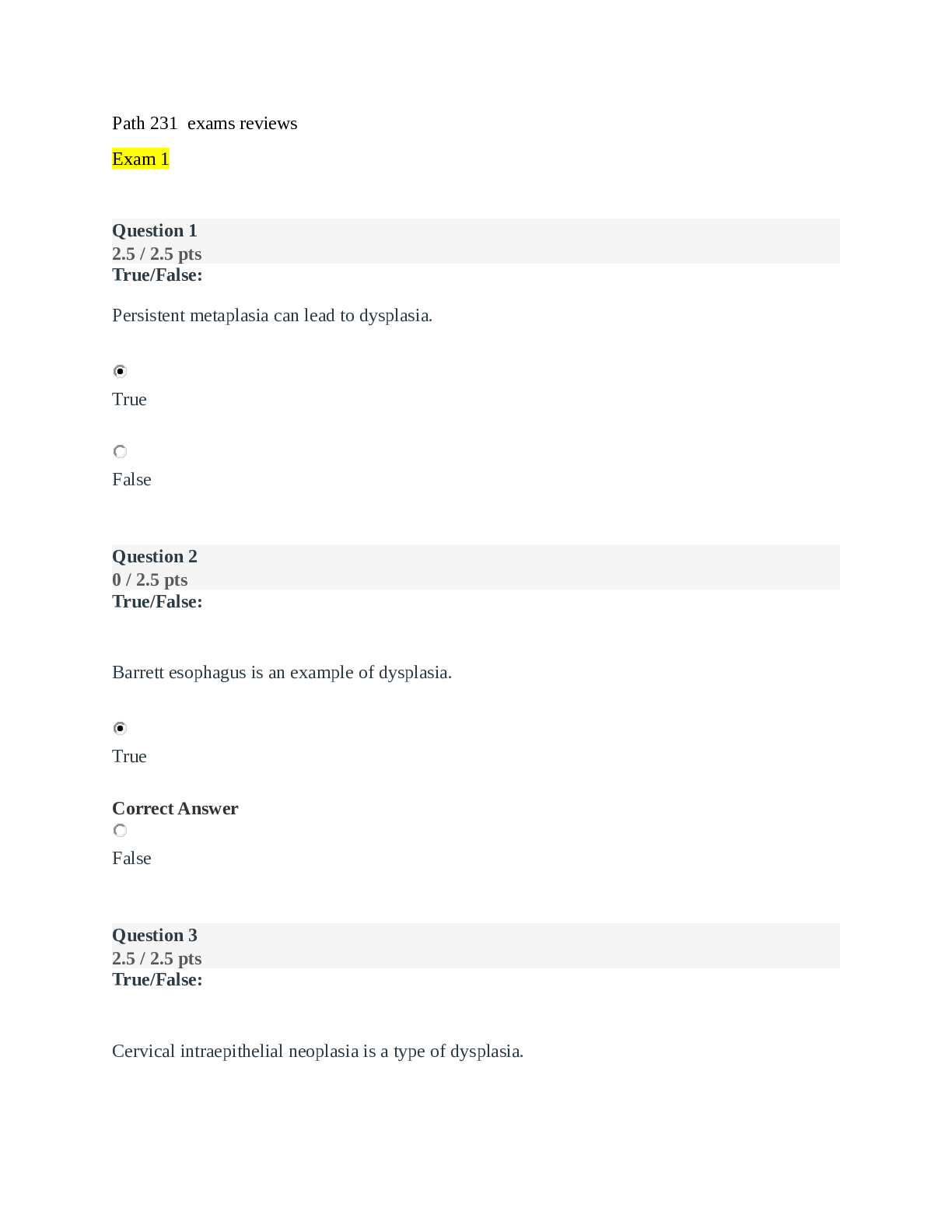
Reviews( 0 )
Document information
Connected school, study & course
About the document
Uploaded On
Aug 13, 2021
Number of pages
109
Written in
Additional information
This document has been written for:
Uploaded
Aug 13, 2021
Downloads
0
Views
54

.png)
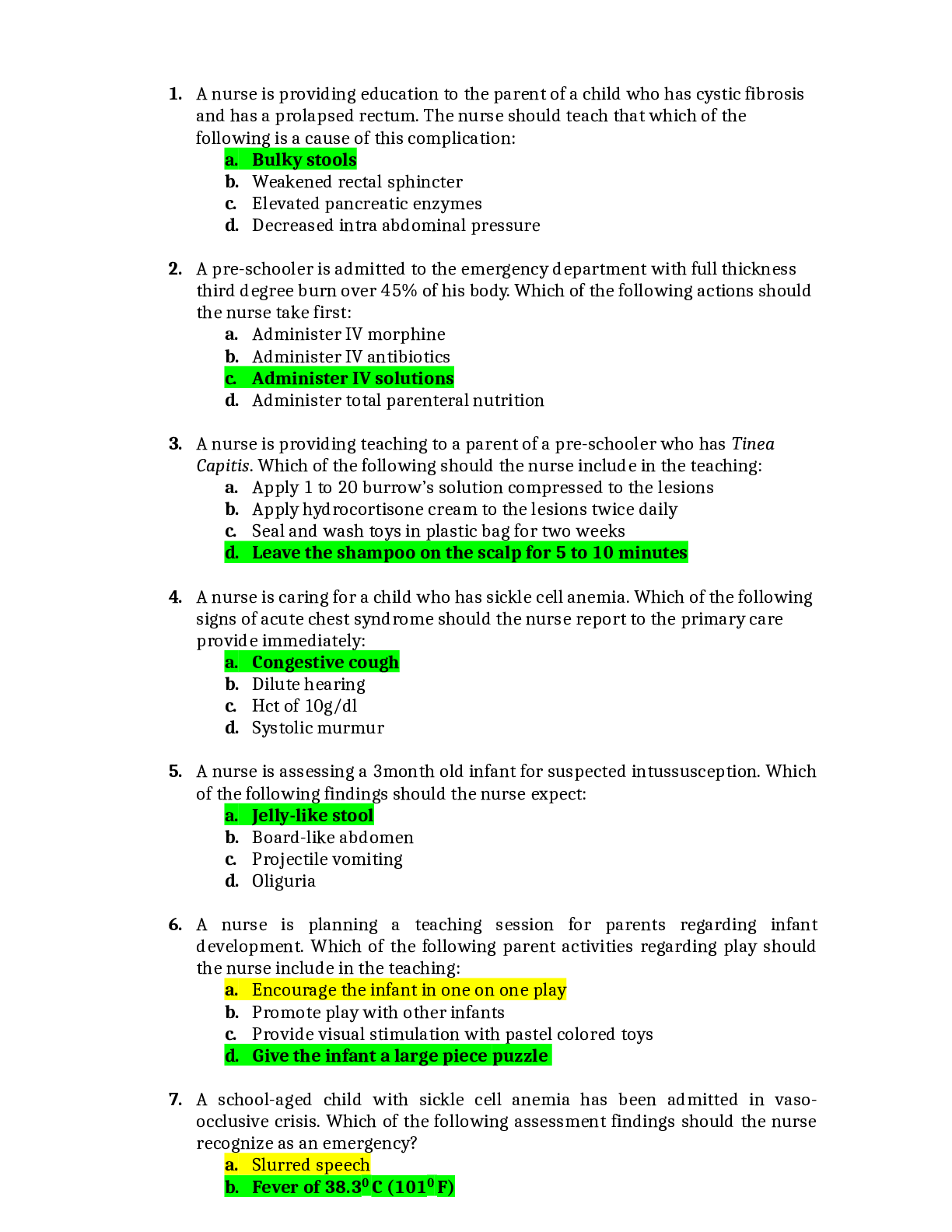


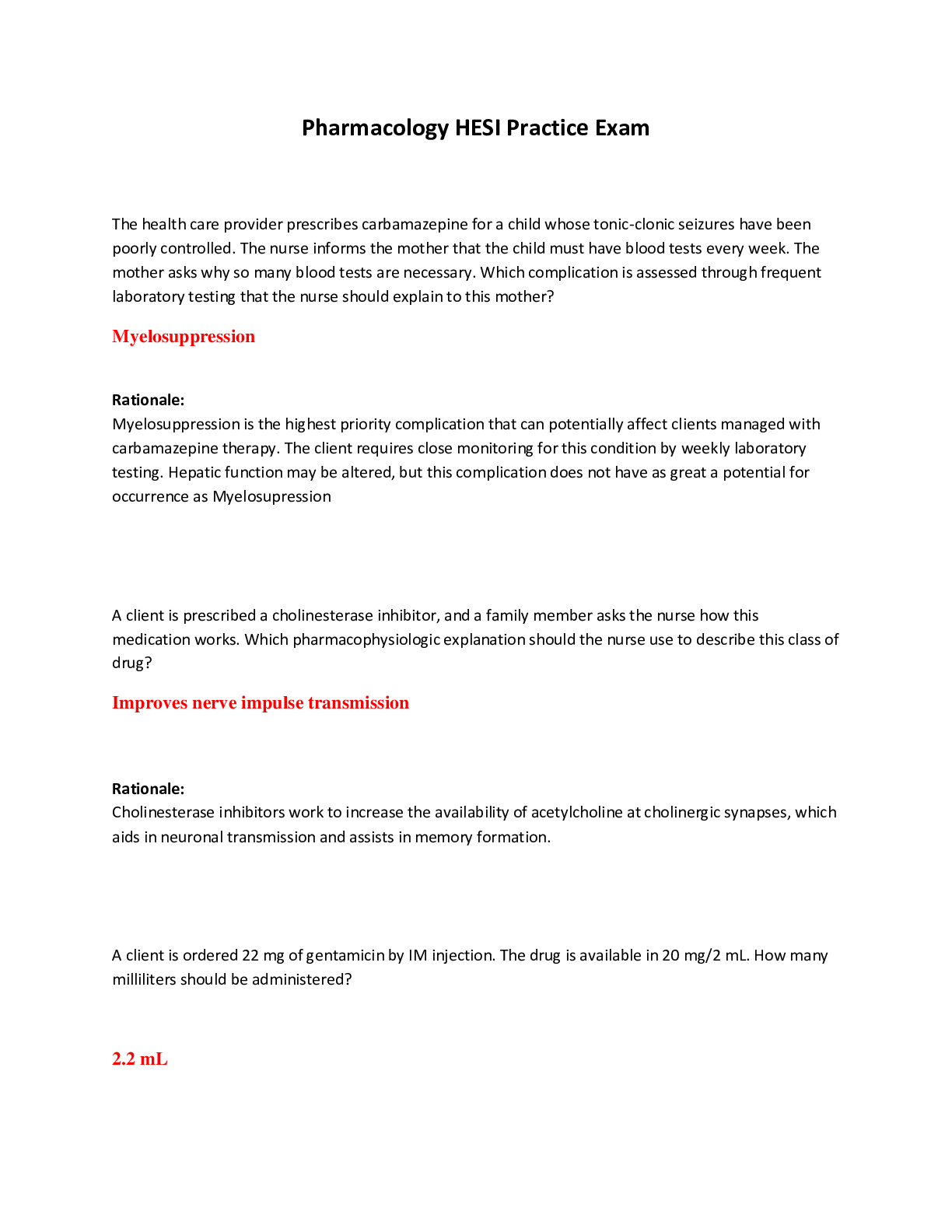


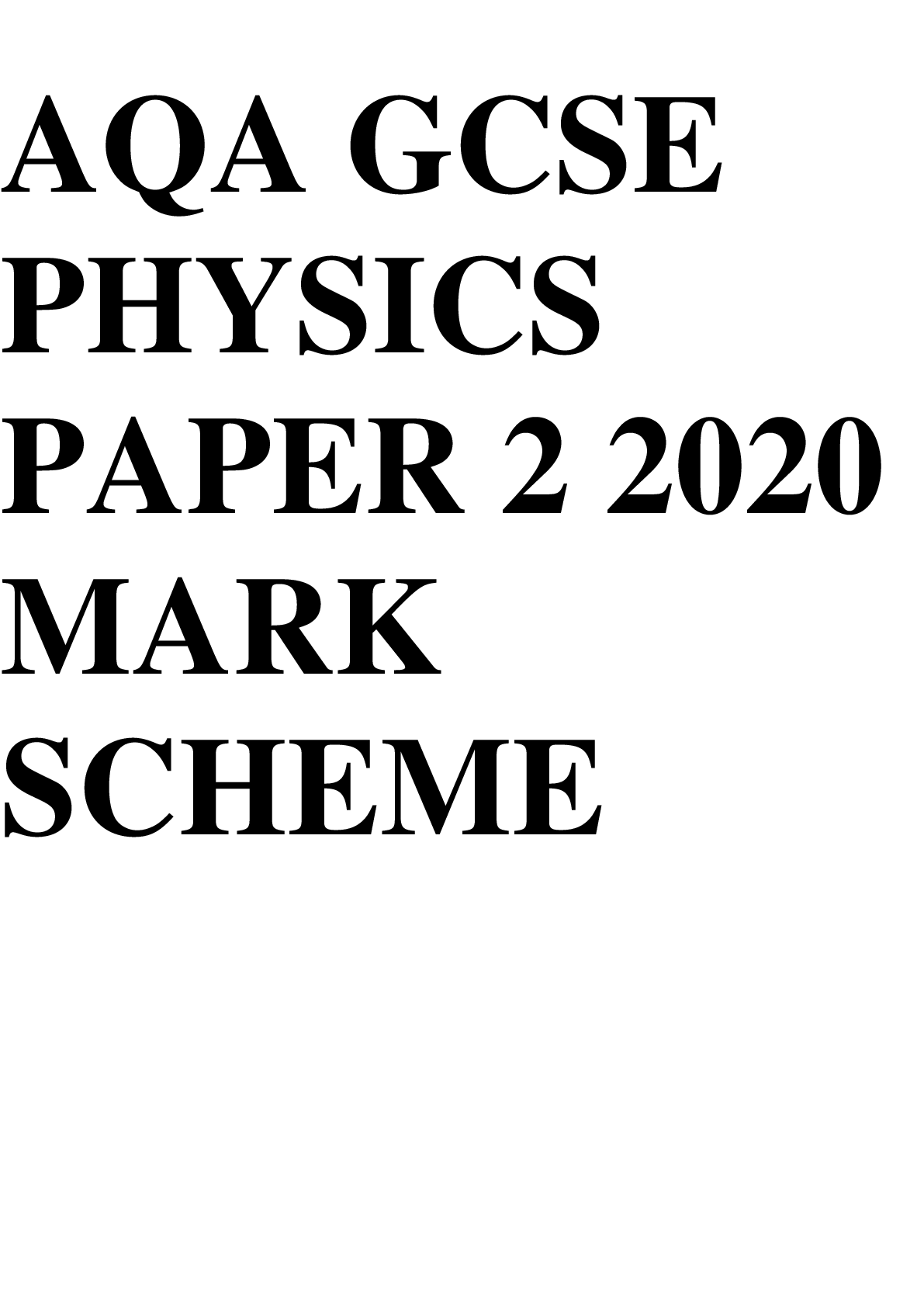

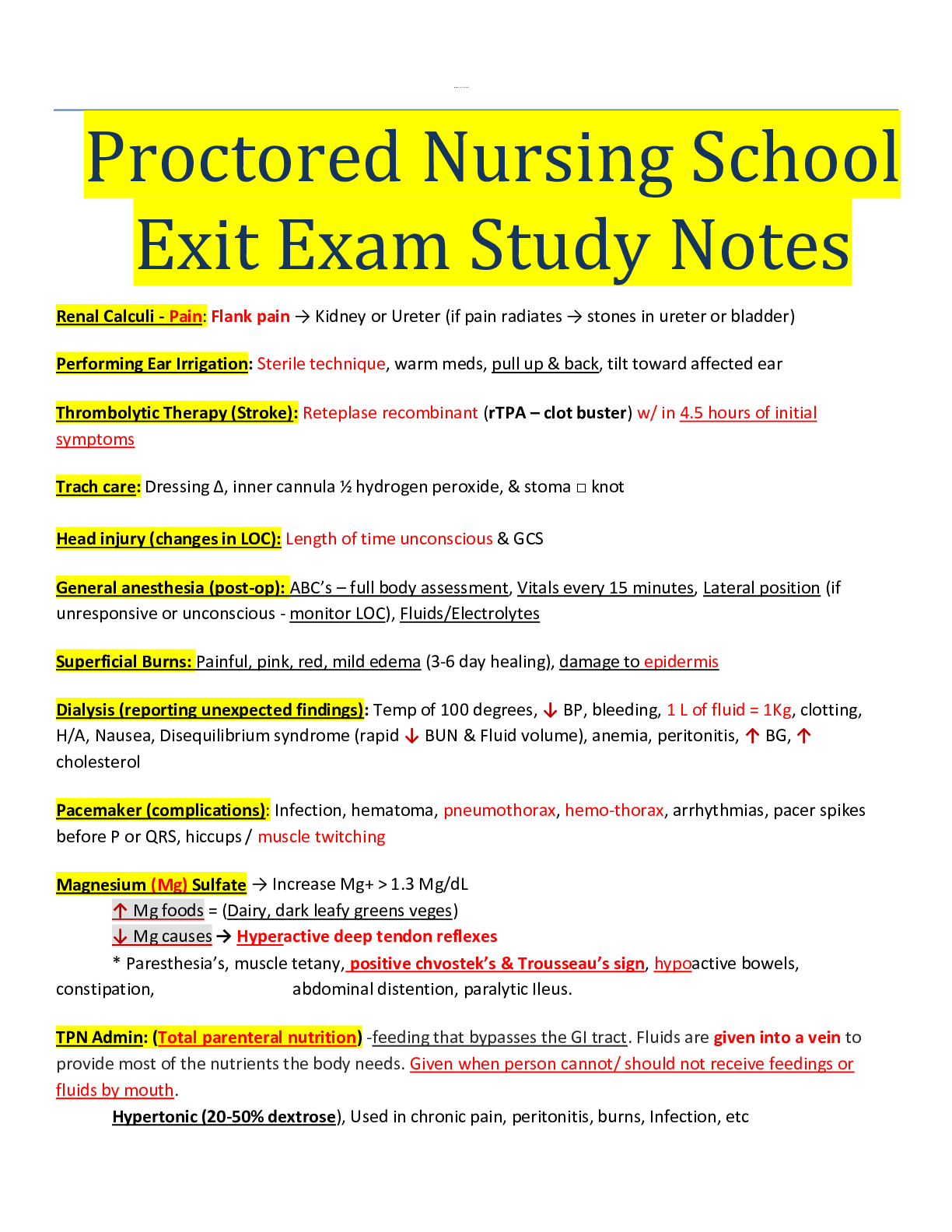
.png)
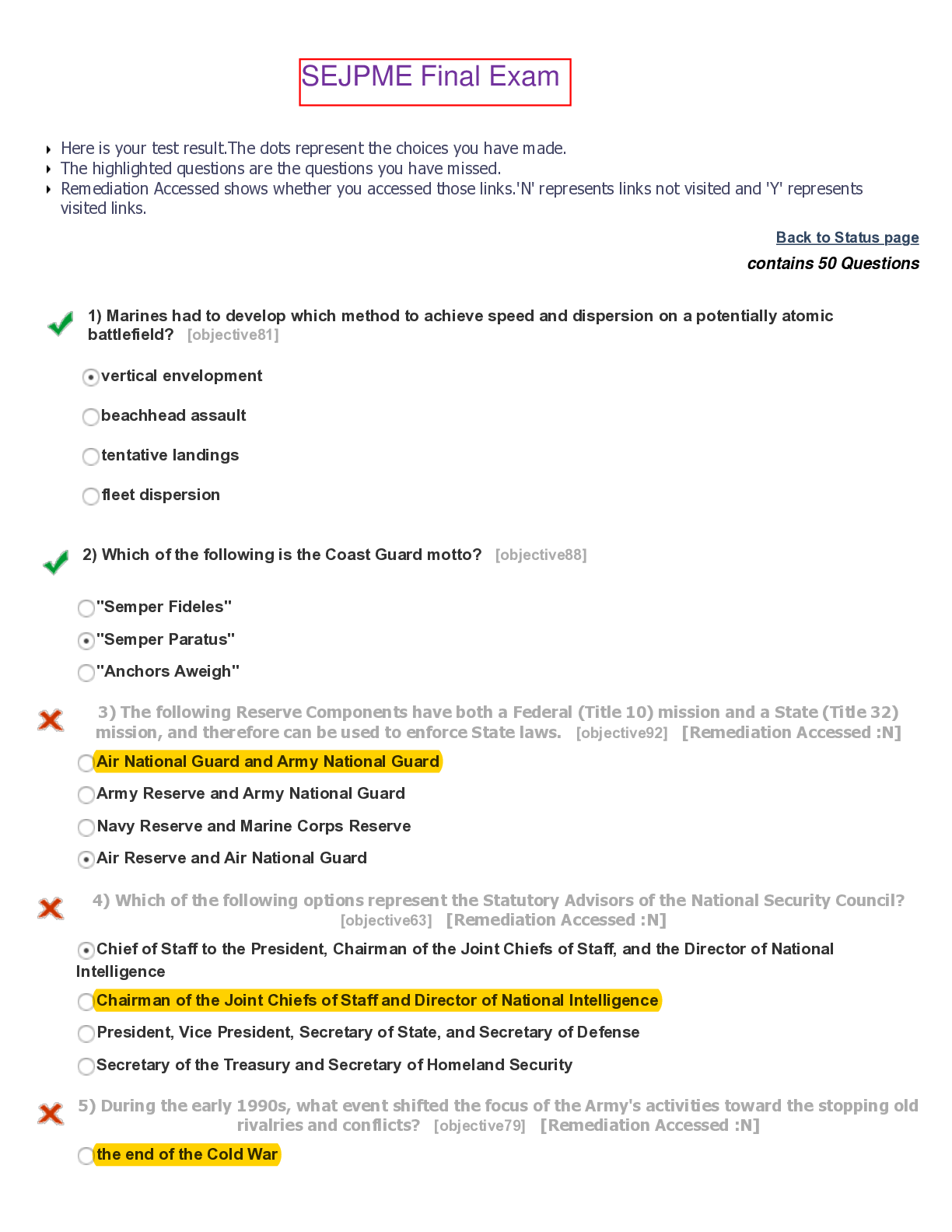
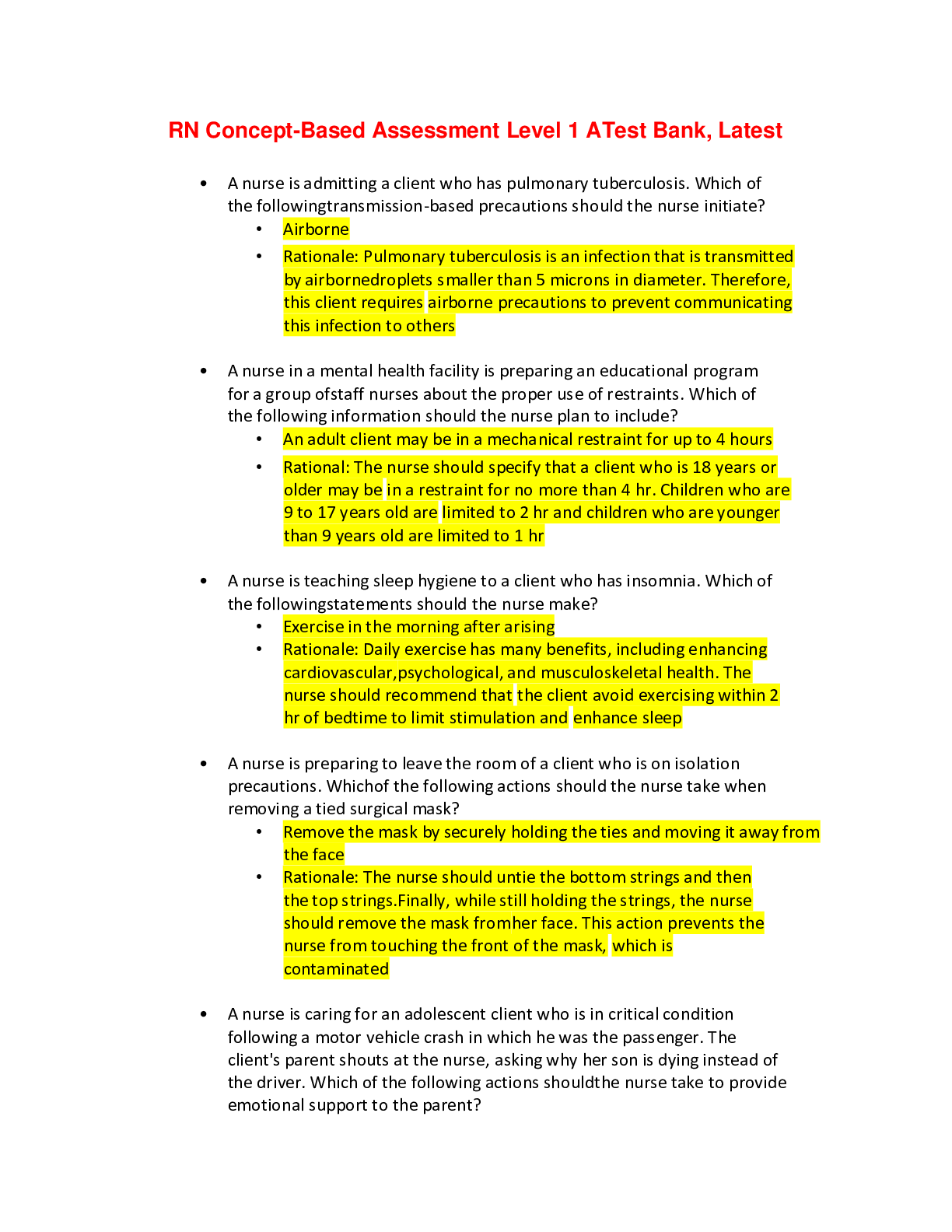
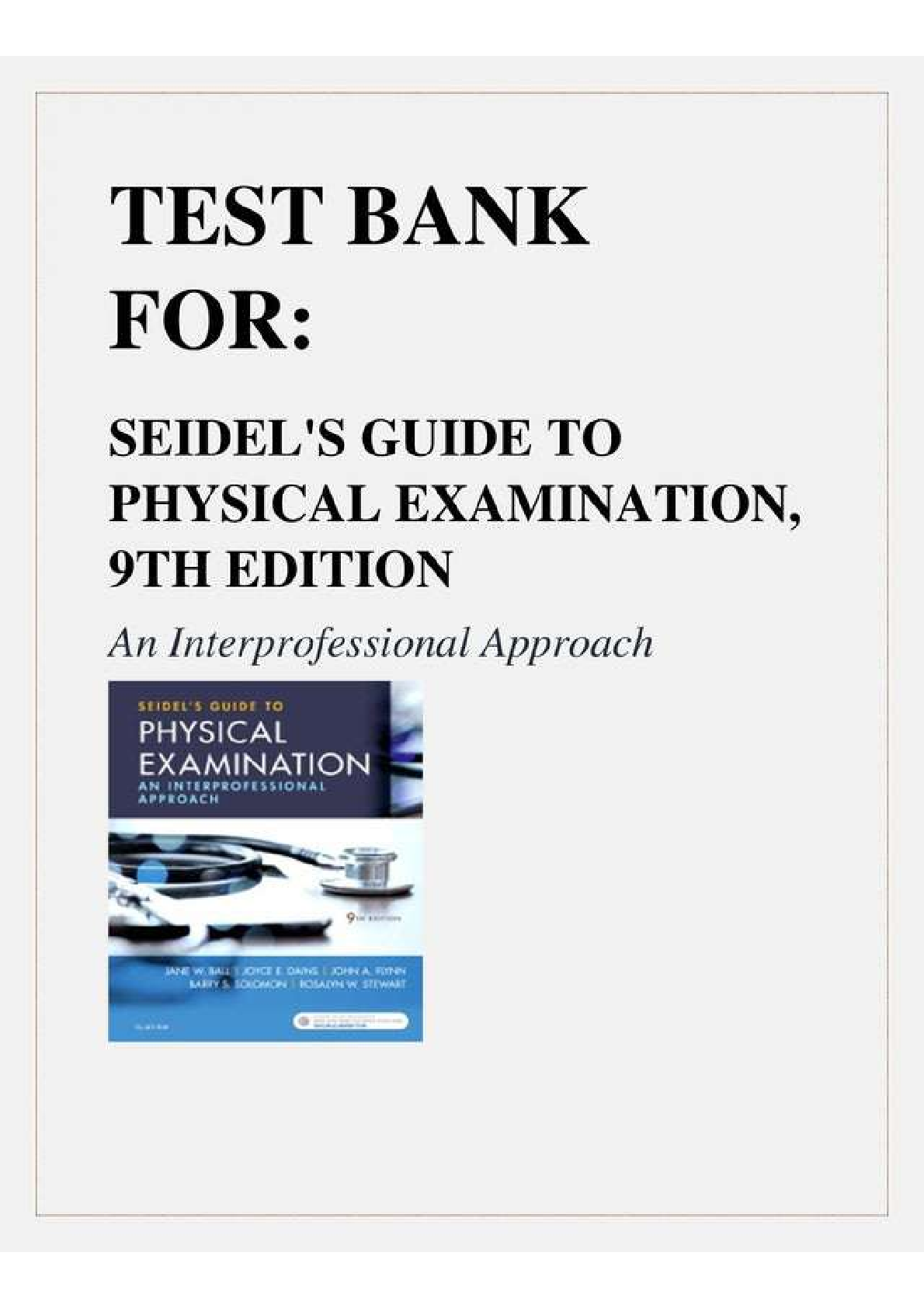

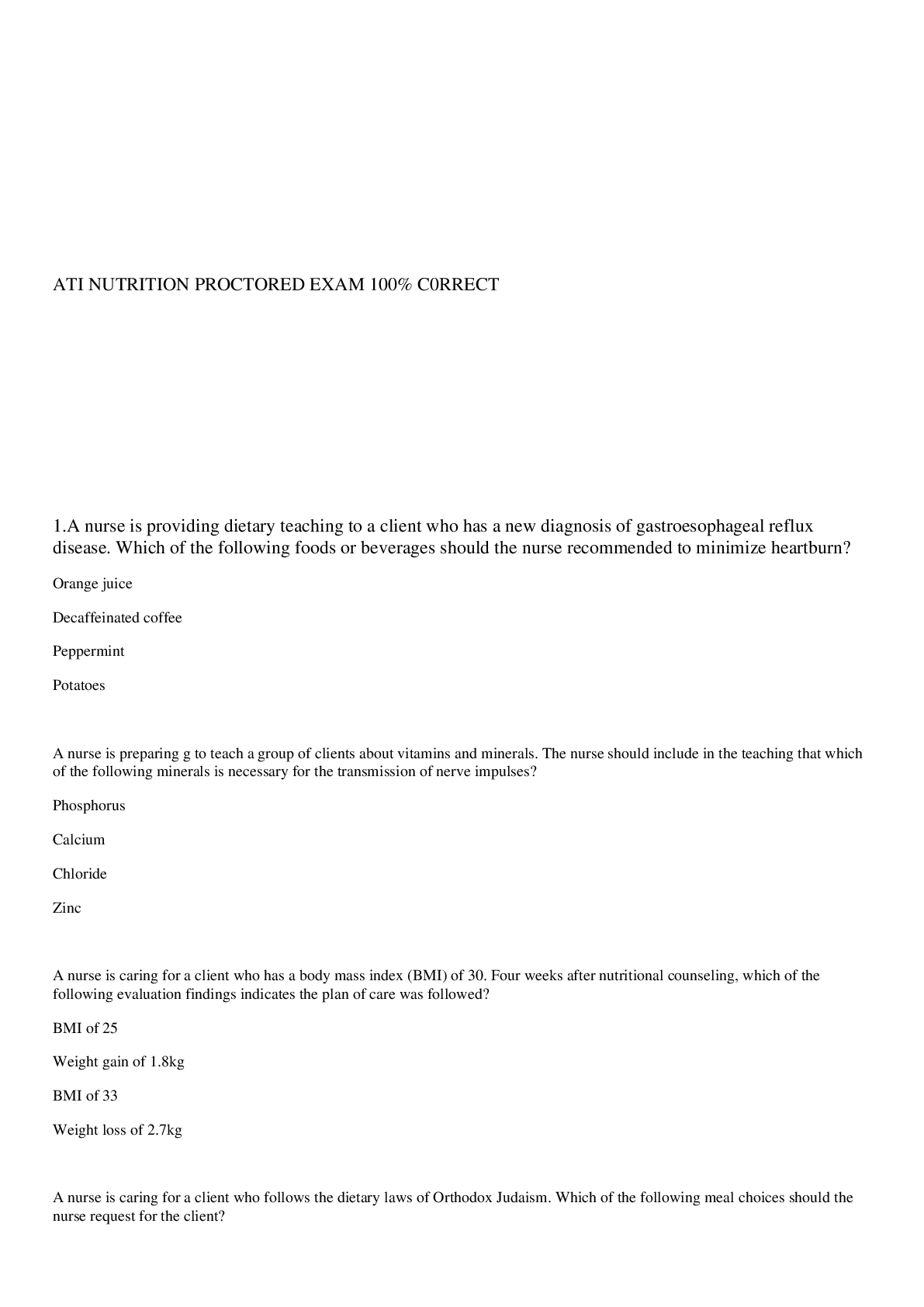
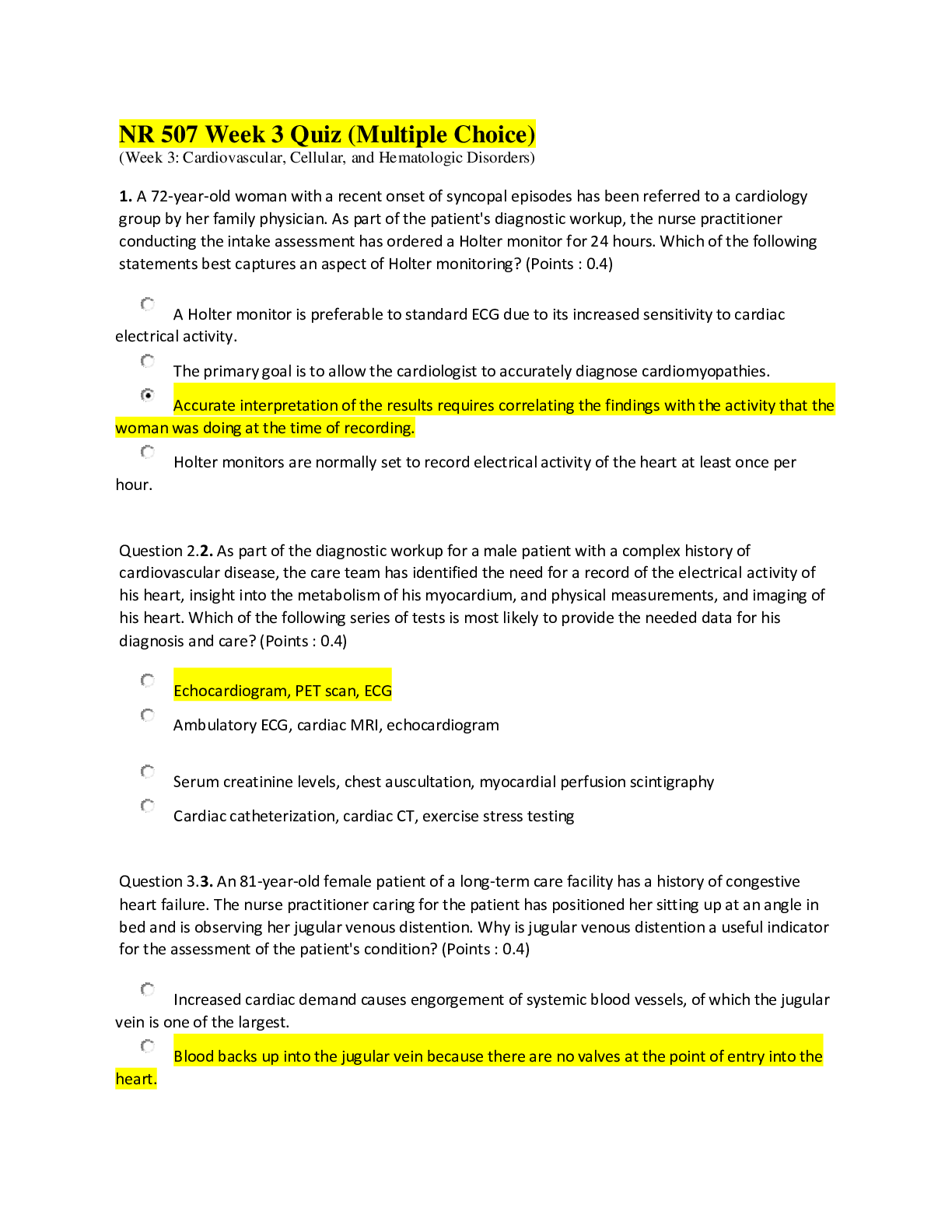
.png)

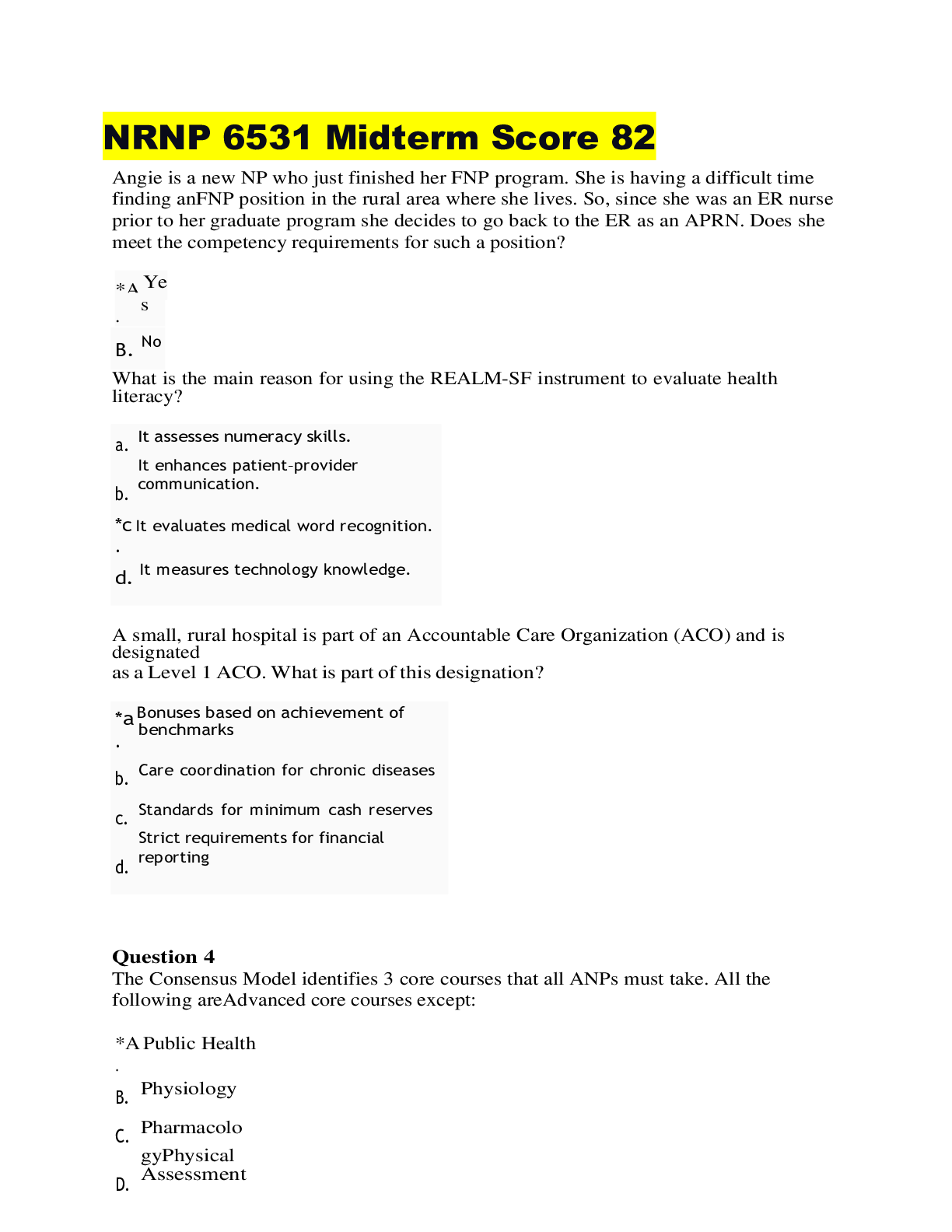
 (1).png)


